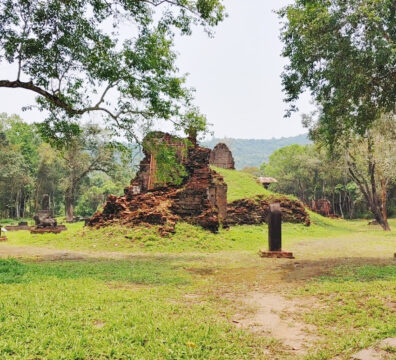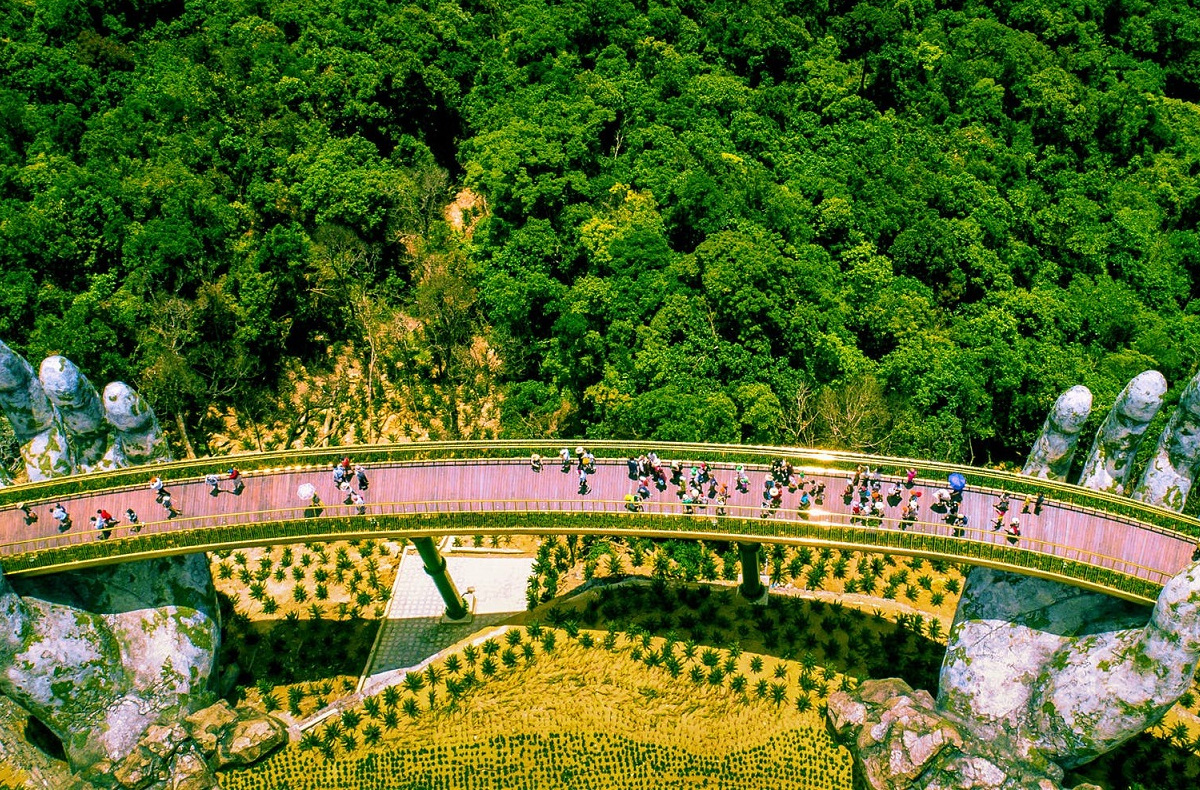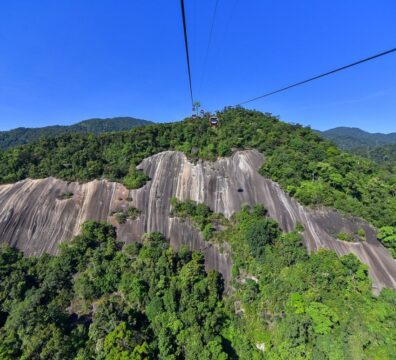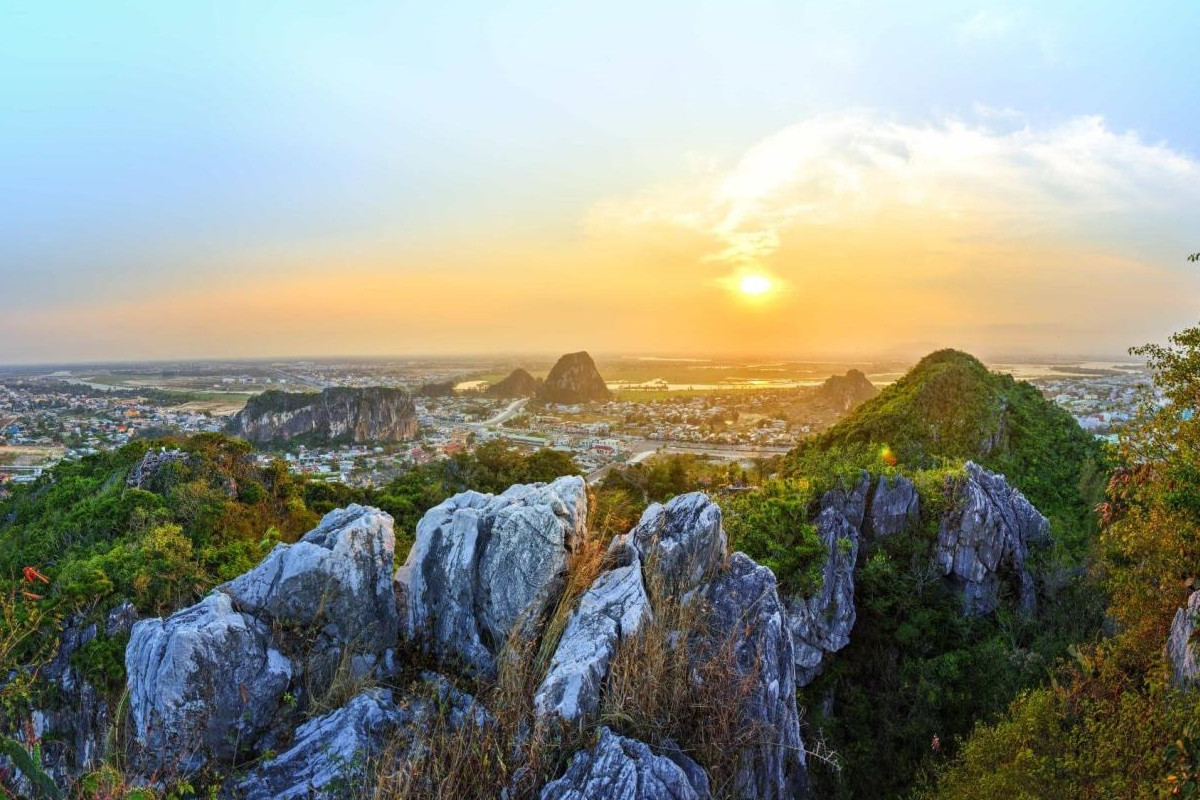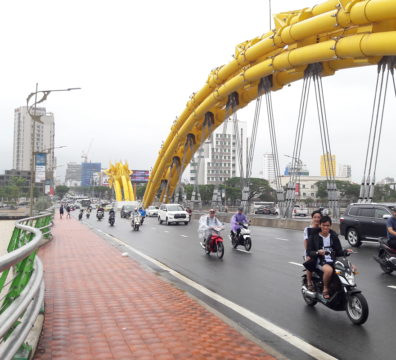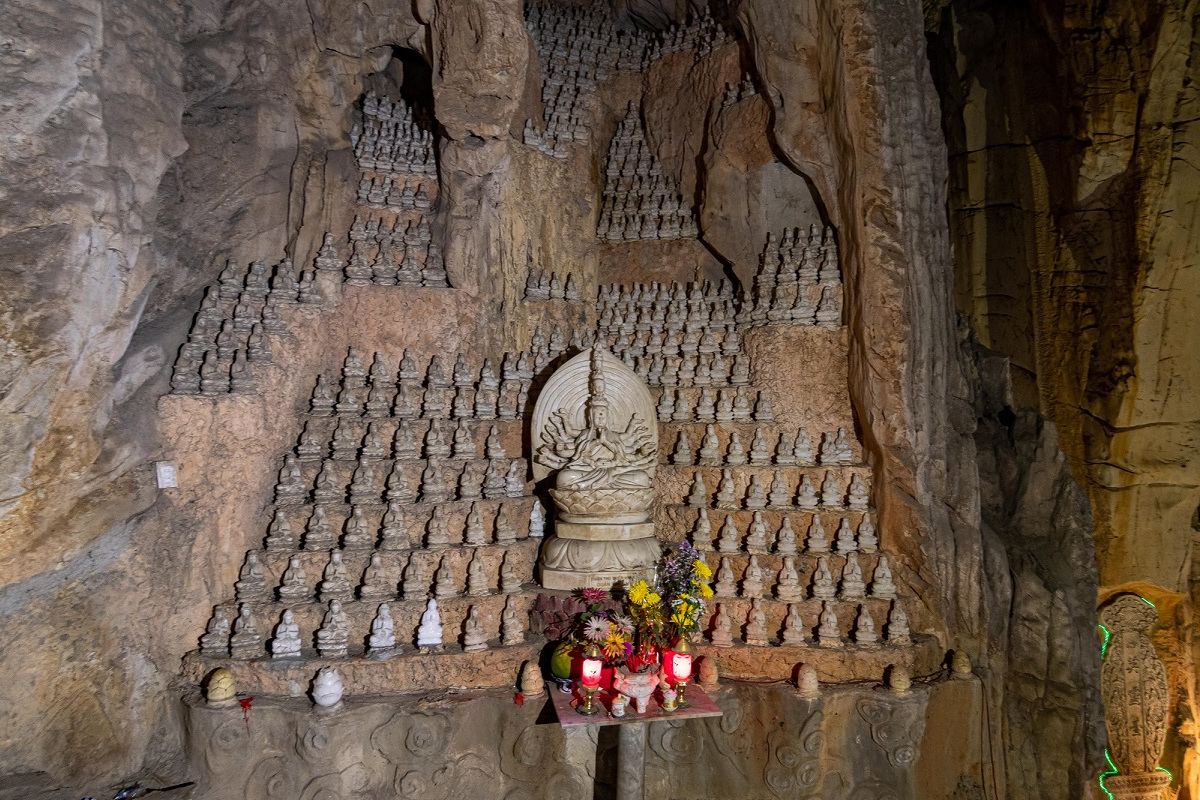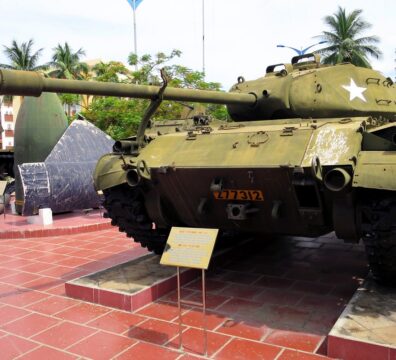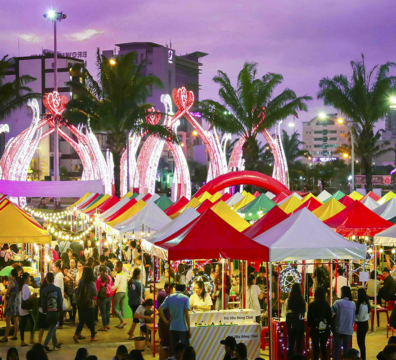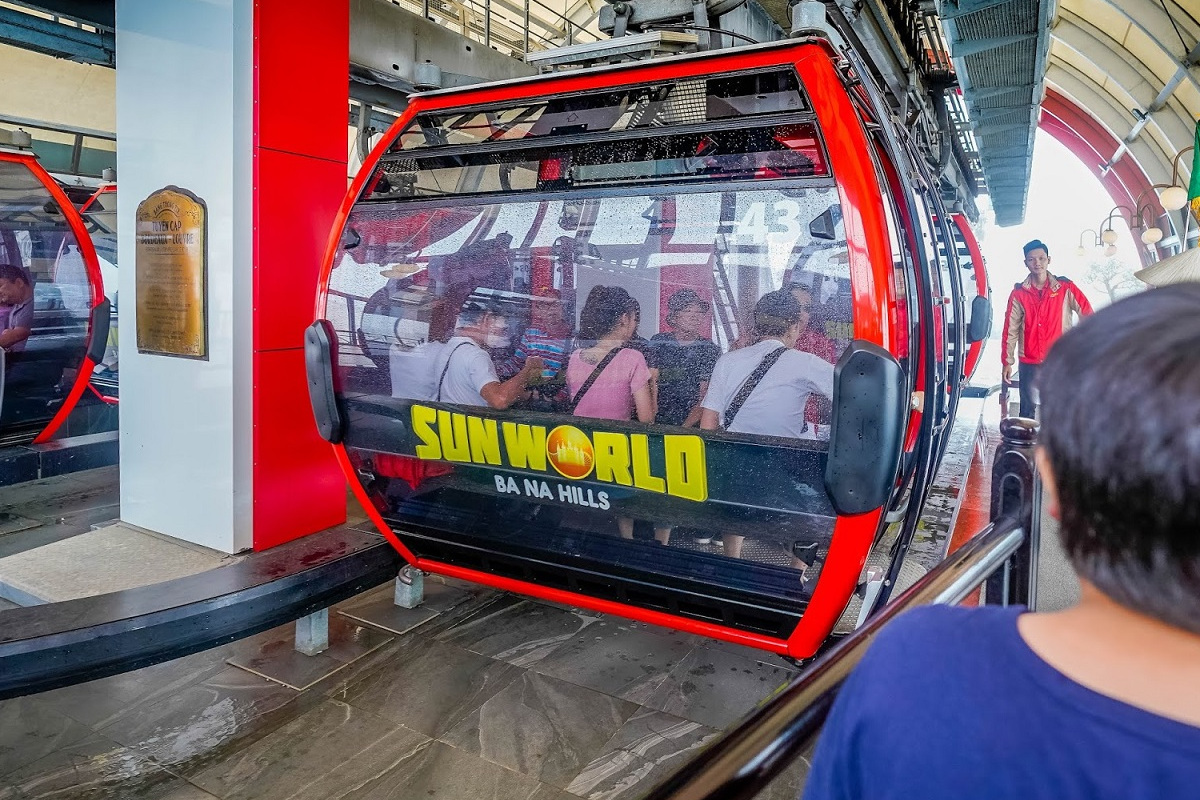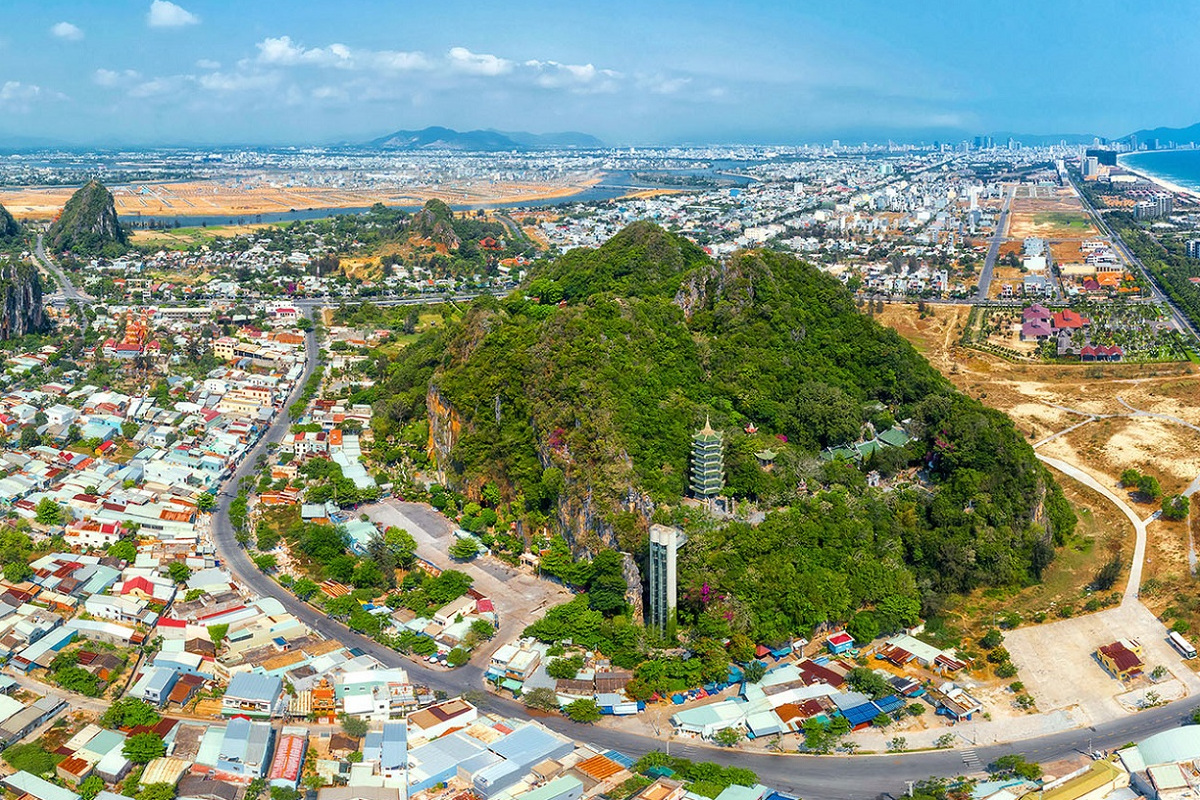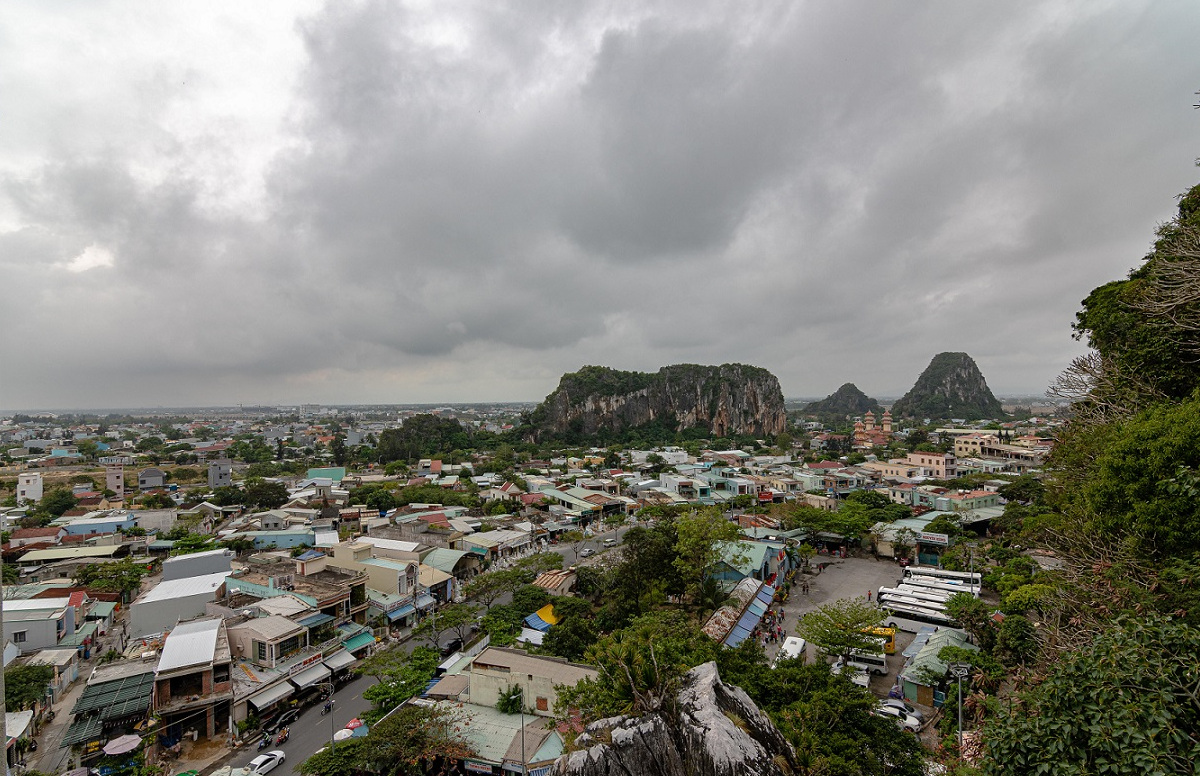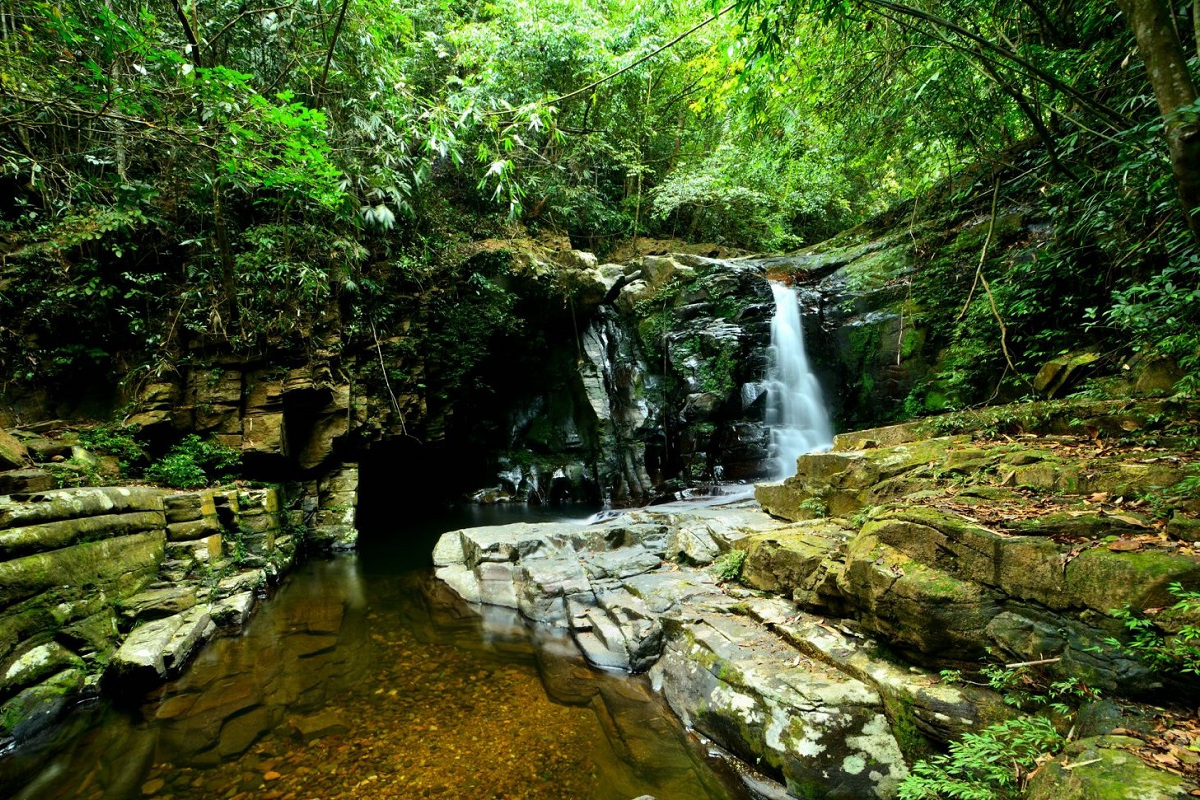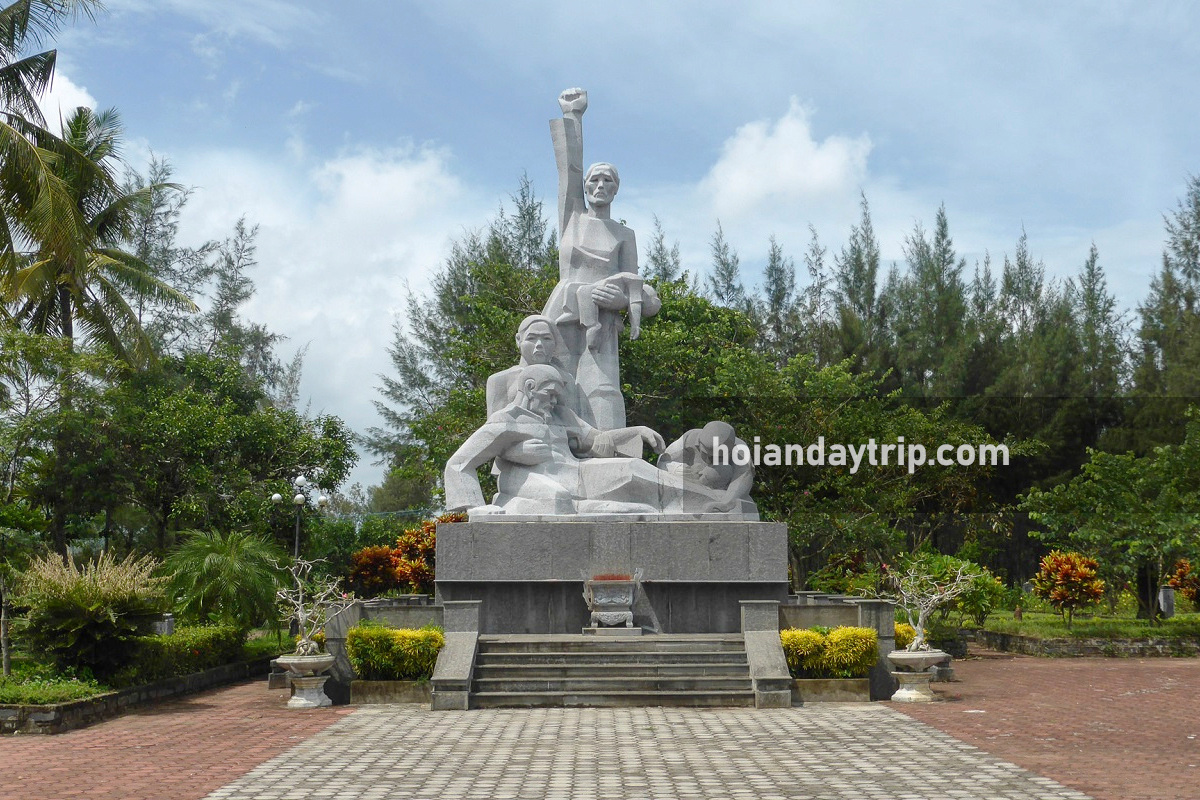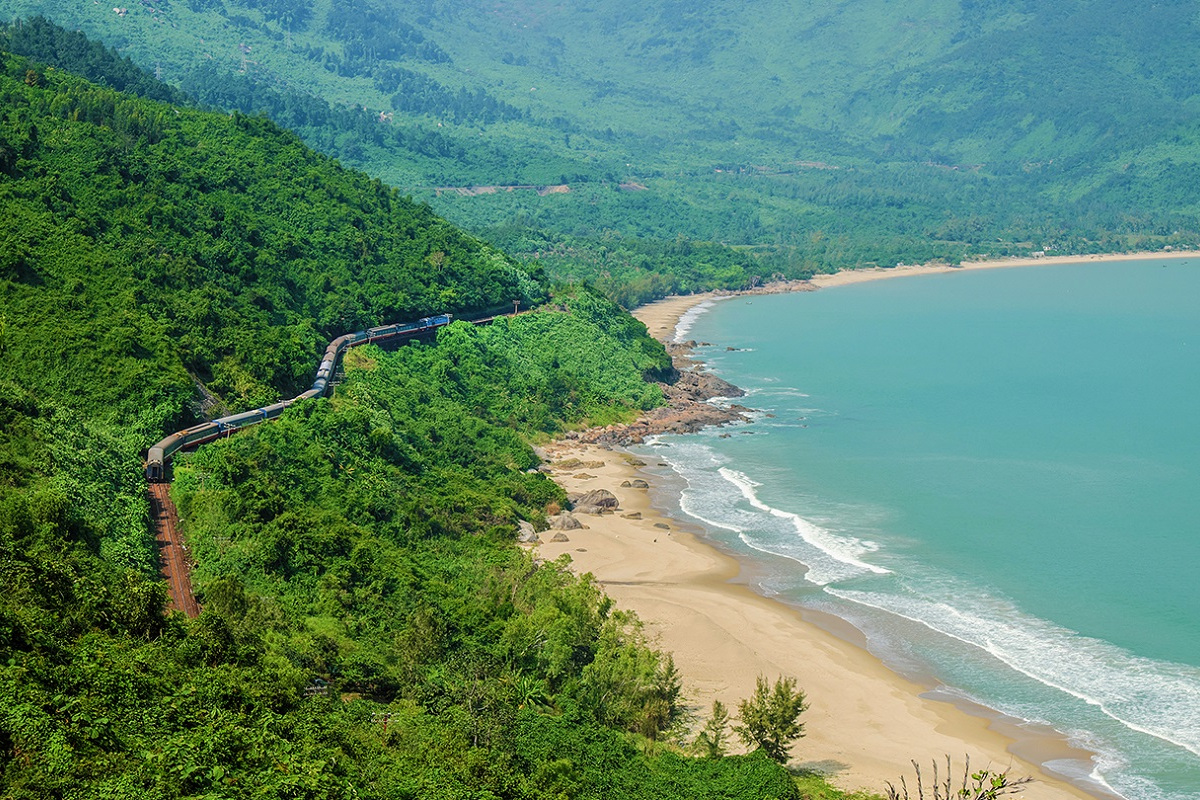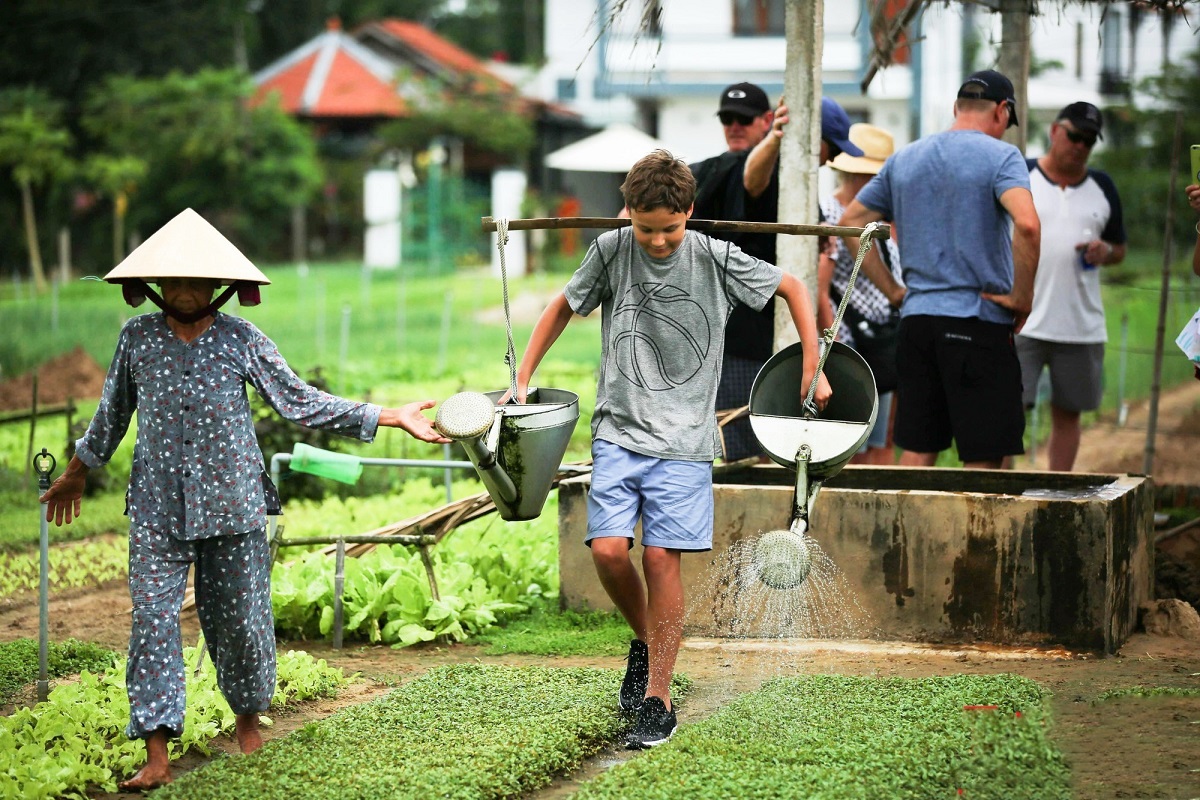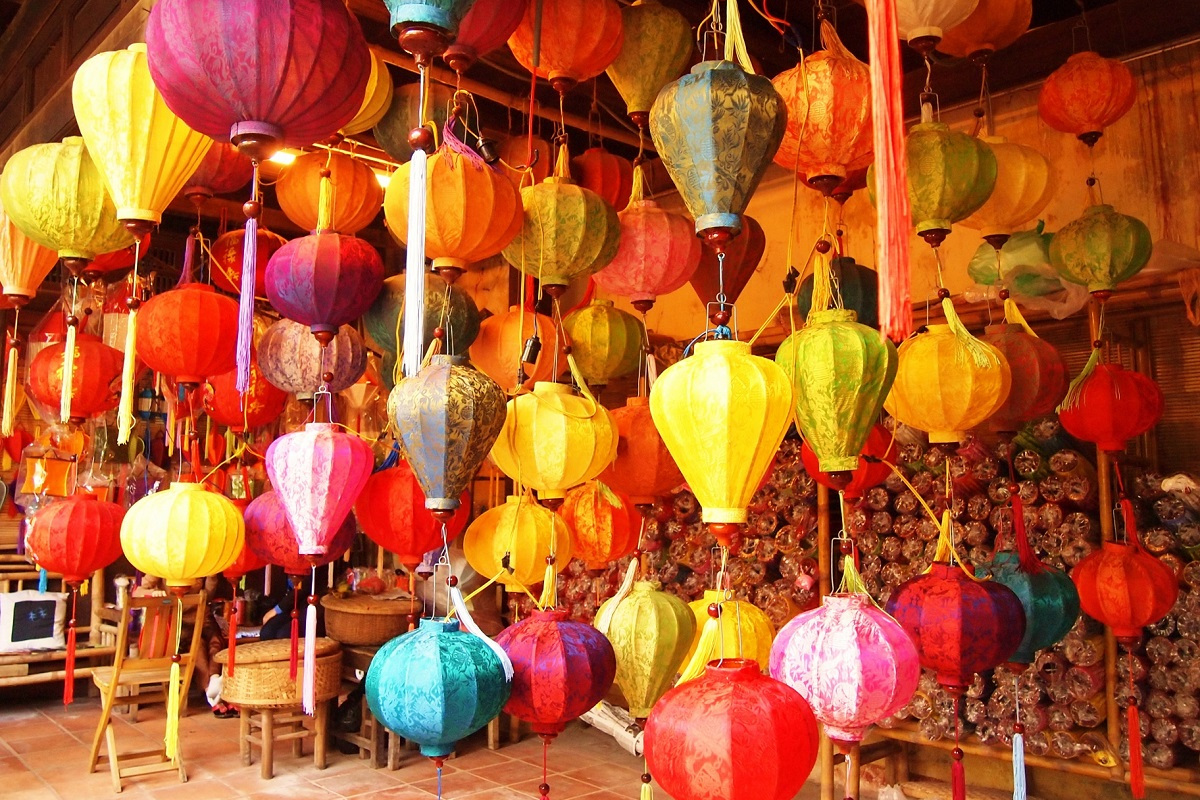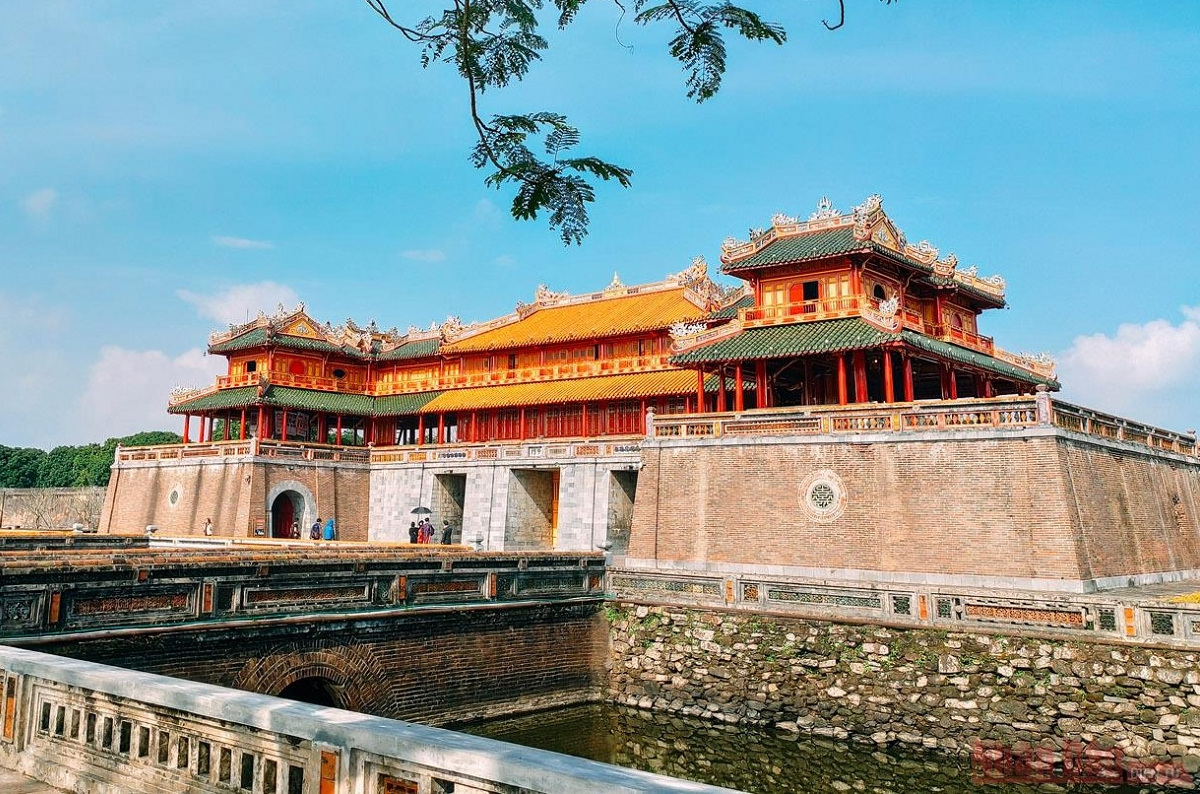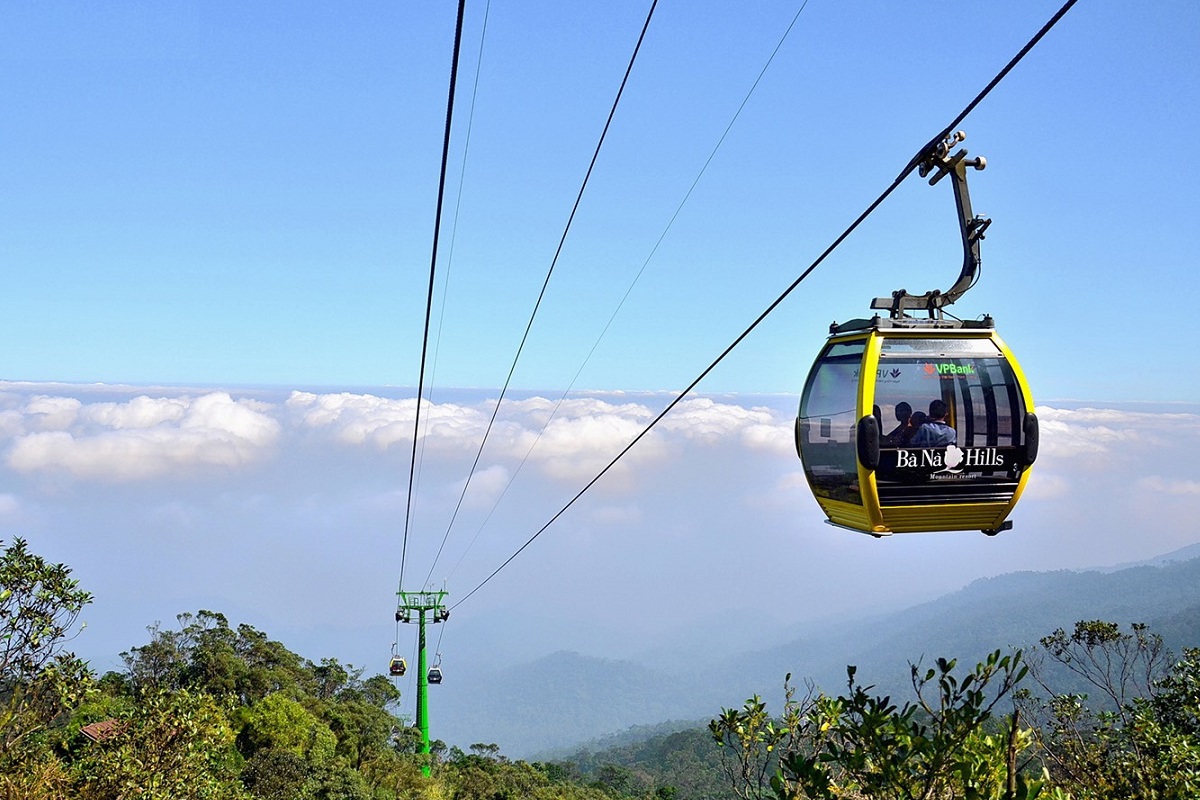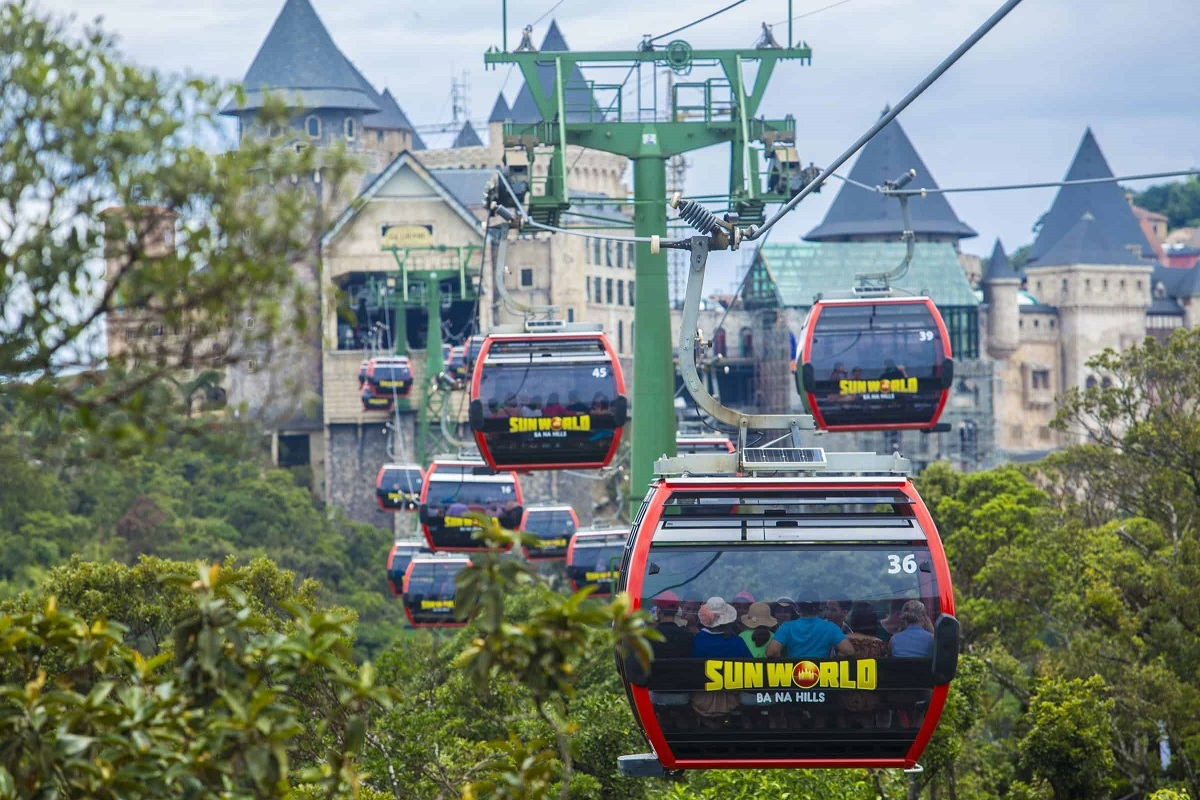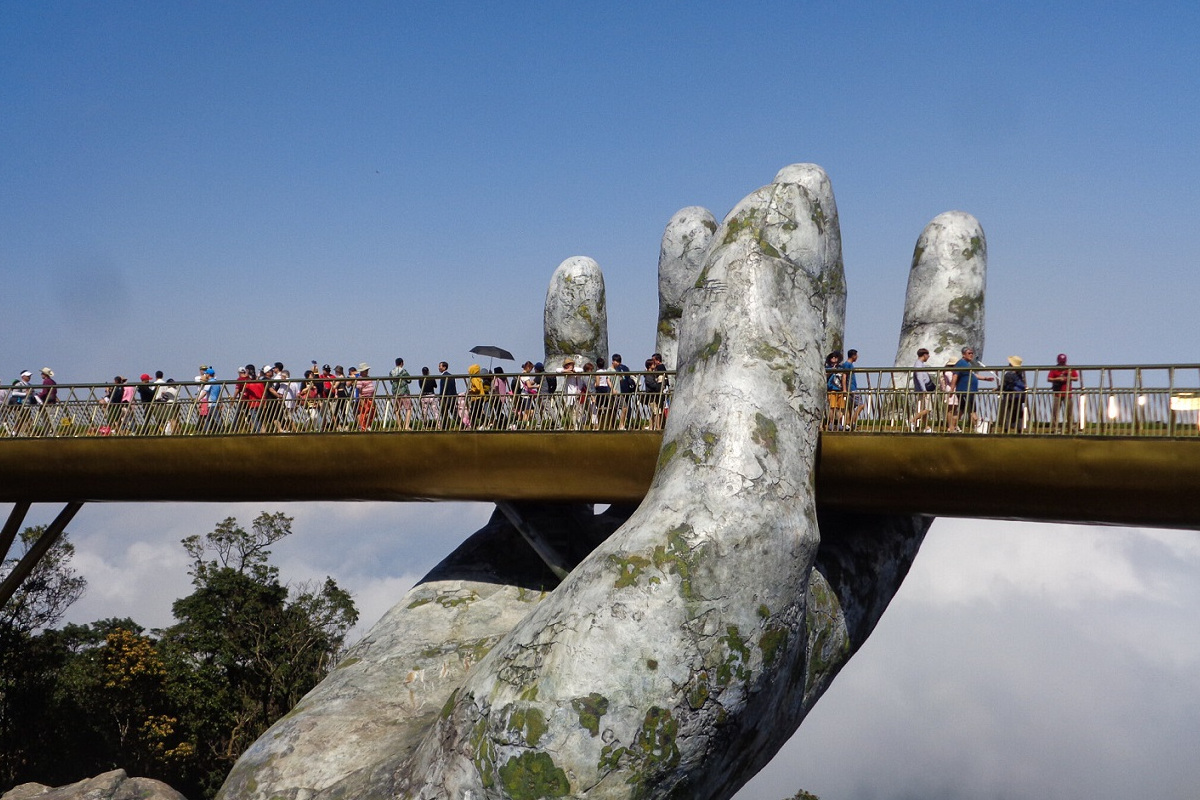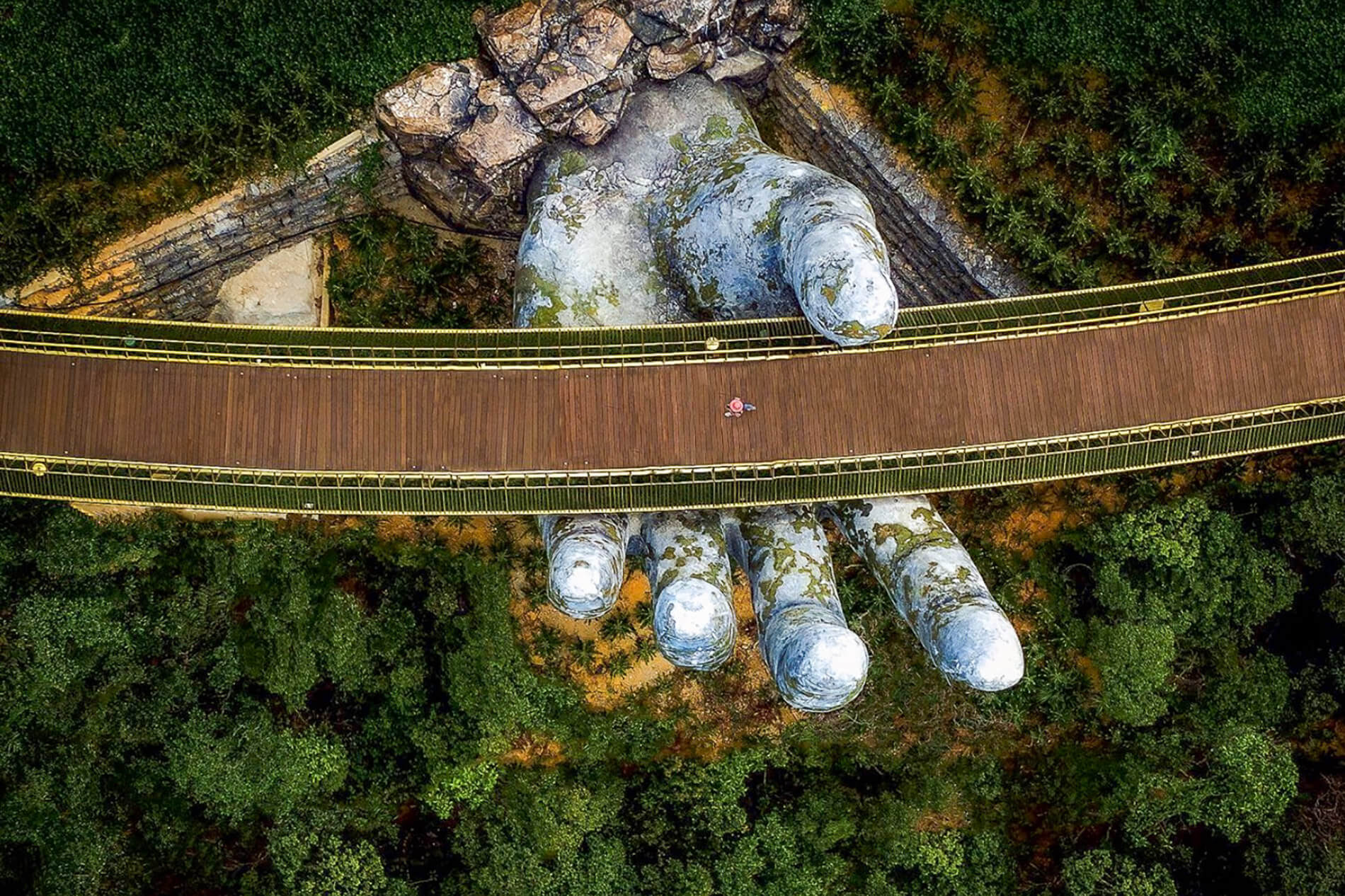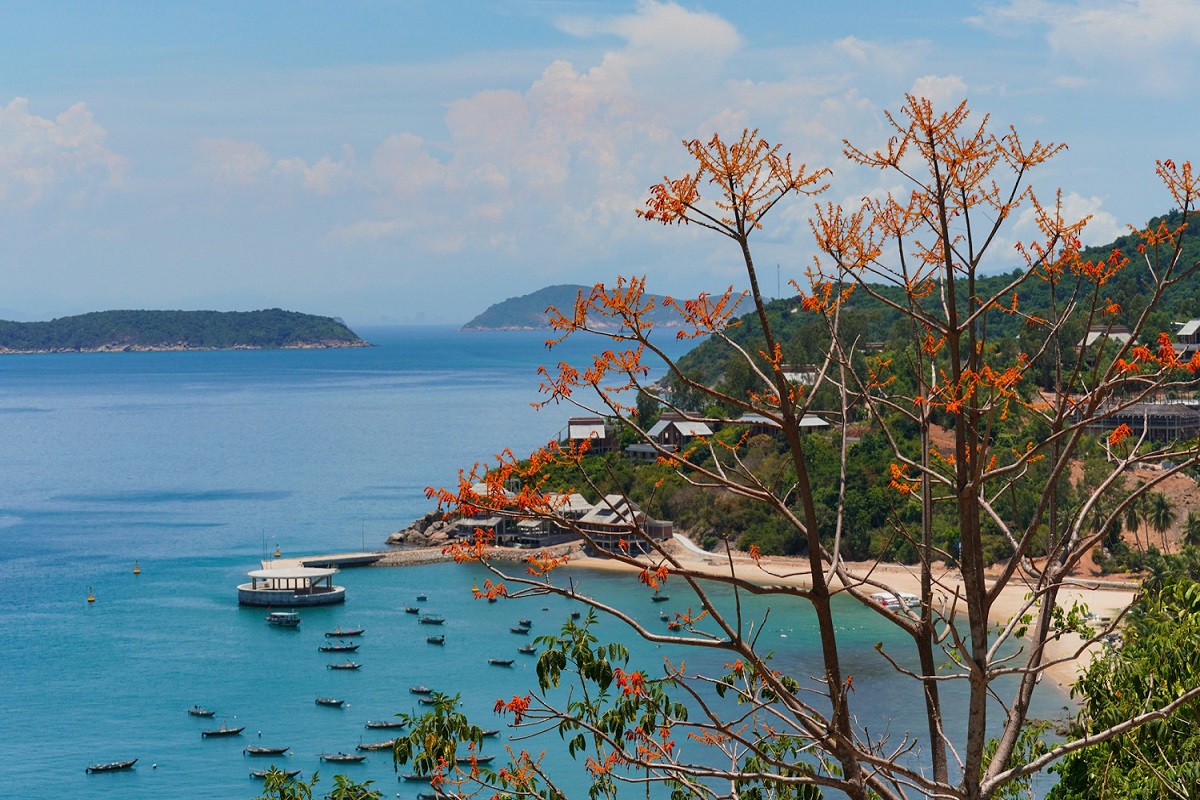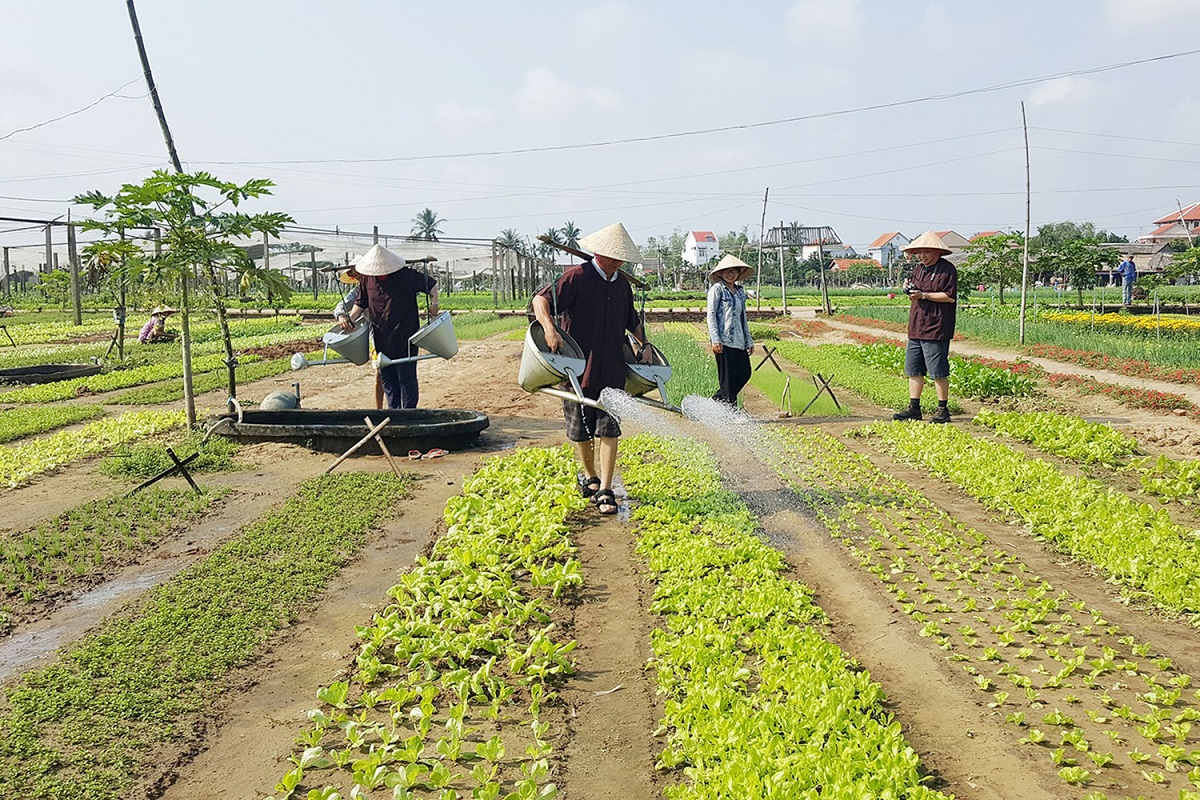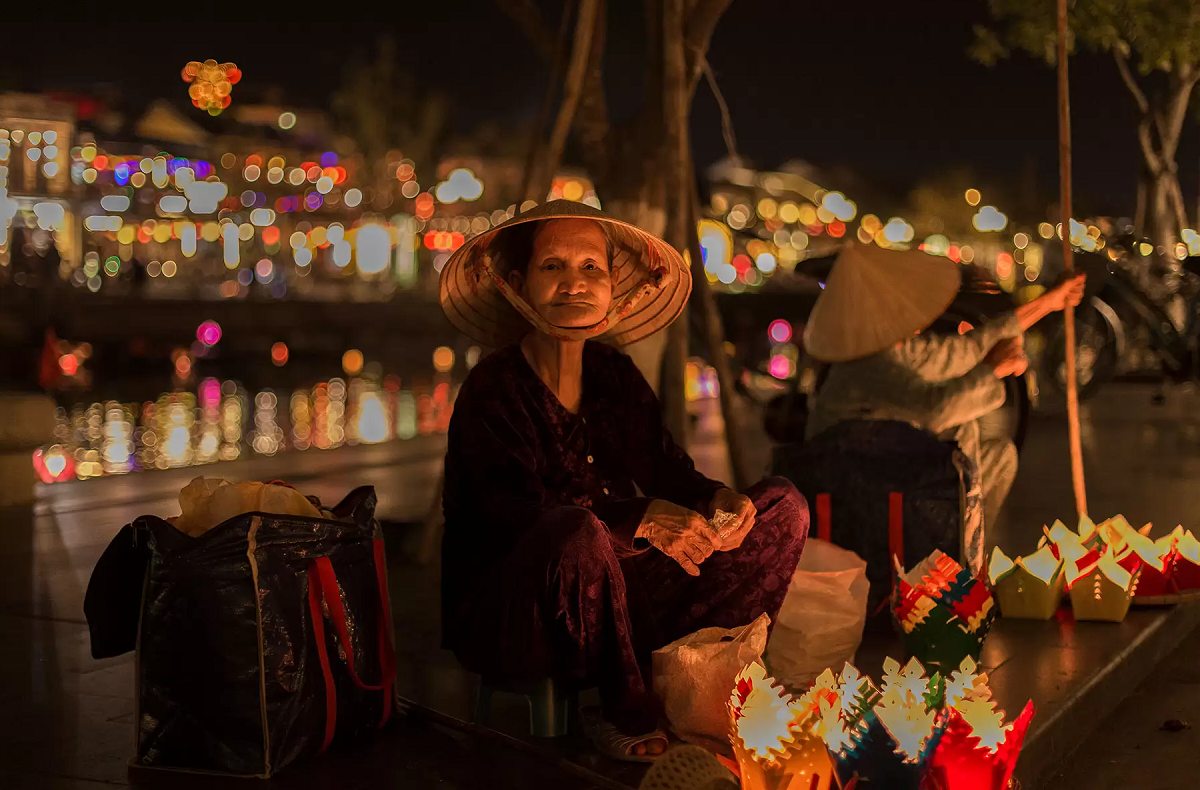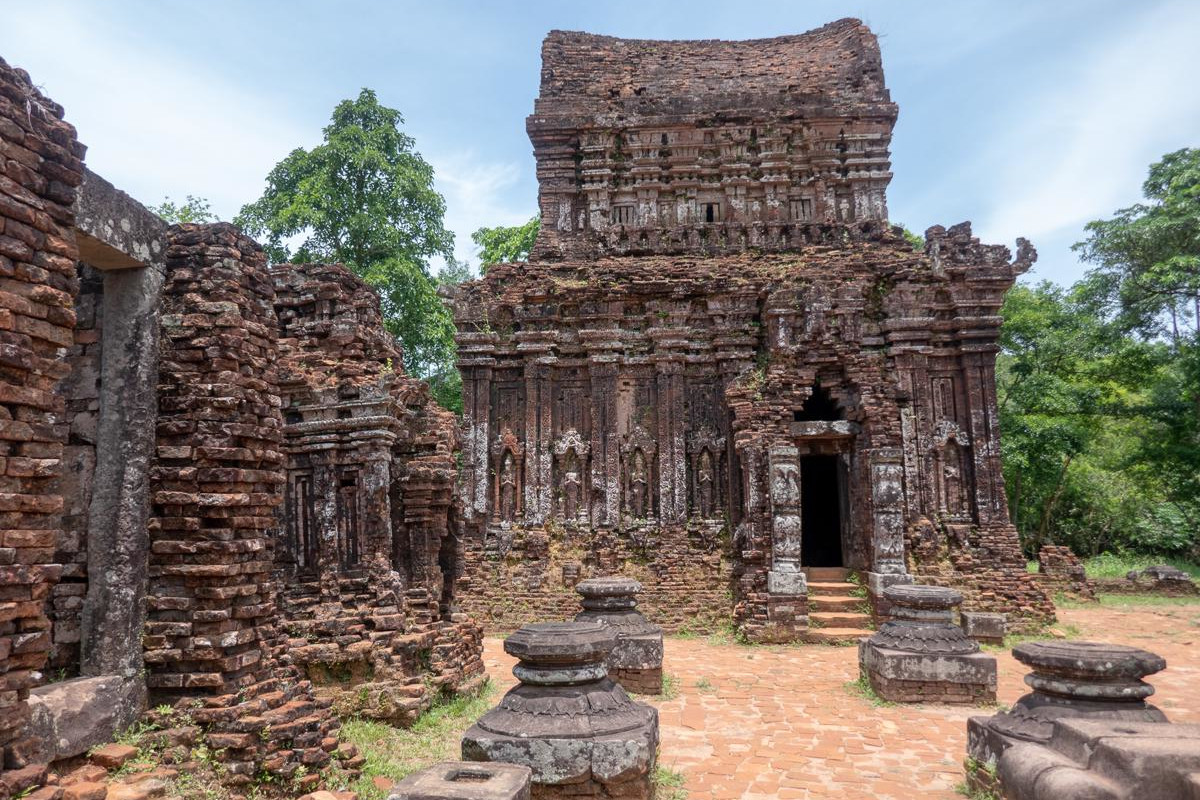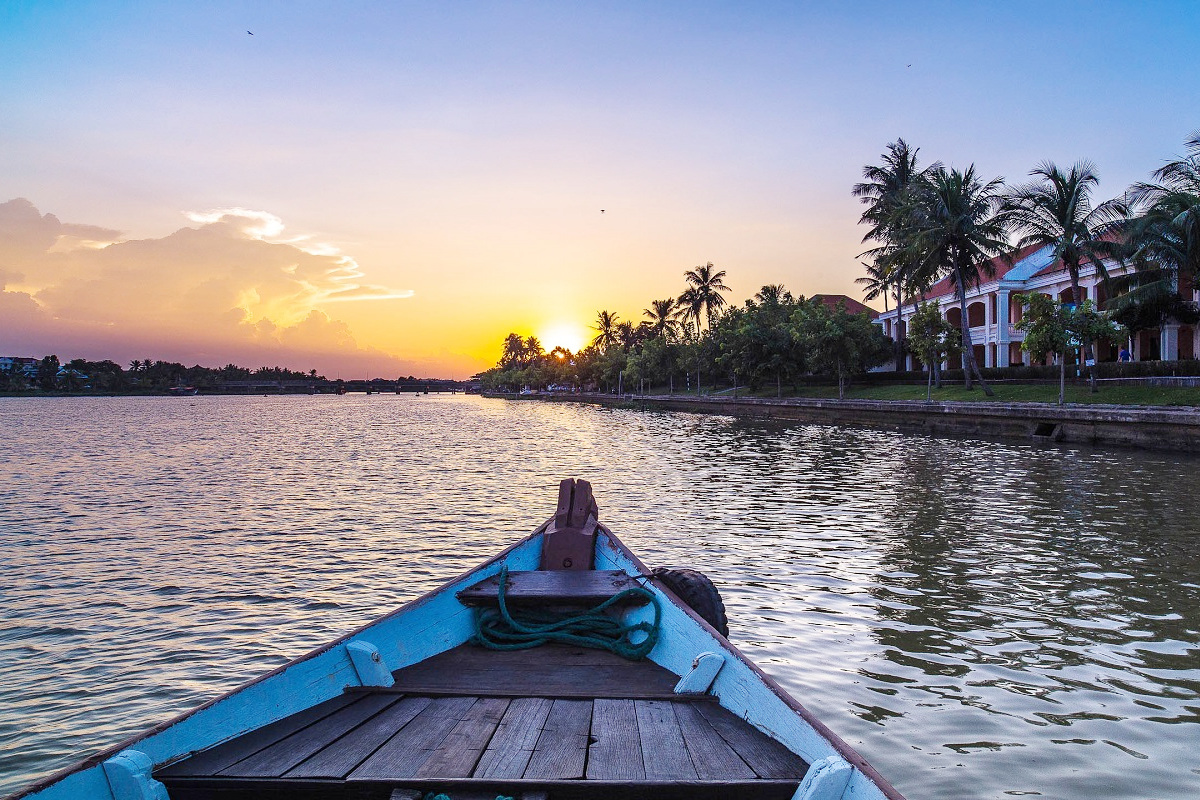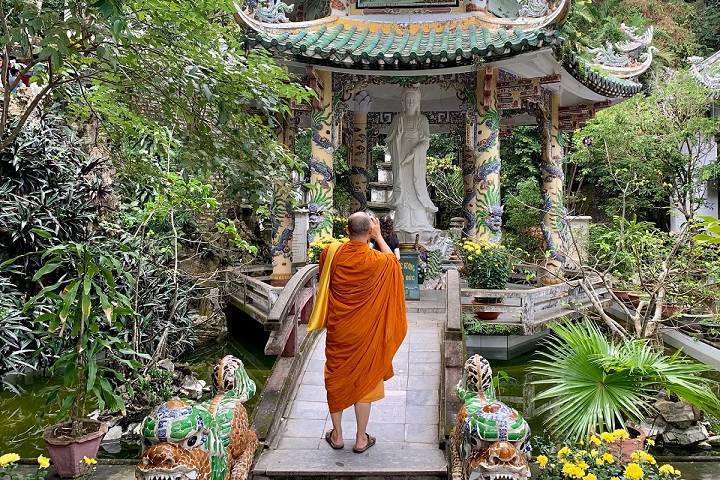Da Nang Museum of Cham Sculpture is a highlight of the Han river waterfront. It’s established by French archaeologists to preserve intricate works of art of Champa kingdom, which ruled the land from 2nd to 14th centuries. Now, it has become the city’s largest museum and a leading one in the country. Off the vibrancy in the outside, visitors enjoy so far ancient artifacts and listen to their history and cultural messages they express. Many of them were praised to be “national treasures” by the Prime Minister. And, many others were moved from My Son holy land, the Hindu sanctuary of the whole kingdom for 1,300 years. If don’t have much time to discover that Unesco world heritage site, a visit here is the best choice to deepen the understanding. All Da Nang city tours include this featured attraction. Therefore, today we outline a complete guide to the Cham Sculpture Museum to provide what you need to know about, prior to getting a ticket and seeing.
See also:

Table of content
- 1 About Da Nang Museum of Cham Sculpture
- 2 Opening Hours and Entrance Fee of Museum of Cham Sculpture
- 3 Exhibitions in Da Nang Museum of Cham Sculpture
- 3.1 Map and Visit Route
- 3.2 Gallery of Tra Kieu
- 3.3 Gallery of My Son Sanctuary
- 3.4 Gallery of Dong Duong
- 3.5 Gallery of Thap Mam
- 3.6 Gallery of Quang Tri, Quang Binh and Hue
- 3.7 Gallery of Da Nang
- 3.8 Gallery of Quang Nam
- 3.9 Quang Ngai
- 3.10 Binh Dinh and Kon Tum
- 3.11 The Inscriptions
- 3.12 Sa Huynh and Champa Potteries
- 3.13 Cham Culture in Ninh Thuan
- 4 National Treasures – The Best in Museum of Cham Sculpture
- 5 How to Get to Da Nang Museum of Cham Sculpture
- 6 Things to See and Do near Da Nang Museum of Cham Sculpture
- 7 Where to Eat near Museum of Cham Sculpture?
- 8 Da Nang Museum of Cham Sculpture Tour
- 9 Related Posts
- 10 Non Nuoc Beach: The Famous Beach of Da Nang
- 11 How to Get from Da Nang to My Son Sanctuary
- 12 Bach Ma National Park: Hiking, Trekking in Da Nang and Hoi An
- 13 Am Phu Cave (Hell Cave) – Things to Do in Da Nang
- 14 Asia Park and Sun Wheel in Da Nang (Sun World Da Nang Wonders)
- 15 How to Get to Golden Bridge from Da Nang
- 16 Da Nang Food Specialties: What to Eat in Da Nang
- 17 How to Visit Golden Bridge Vietnam
- 18 Da Nang Shore Excursions: Guided Tours From Tien Sa Port
- 19 Han Market (Cho Han): Where to Shop in Da Nang?
- 20 Da Nang Cathedral (Da Nang Pink Church)
- 21 Things to Do in Ba Na Hills Besides Golden Bridge
- 22 Da Nang Half Day Tours
- 23 Da Nang Private Car and Driver
- 24 Da Nang and Hoi An Itinerary for Visitors Staying Overnight in Hoi An
- 25 Da Nang Things to Do: Guide to What to Do in Da Nang Vietnam
- 26 Da Nang Best Things to Do and Reasons
- 27 How to Get From Hoi An to Da Nang
- 28 Hoi An or Da Nang: Which is Better for First Time Visitor?
- 29 My Son Sanctuary Tour
- 30 Da Nang Best Area to Stay: Guide to Where to Stay in Da Nang
- 31 Da Nang Cave Tour: Best Underground Activities in Da Nang
- 32 Da Nang Best Time to Visit: Guide to Best Weather in Da Nang
- 33 Da Nang Weather by Month: Guide to Monthly Weather in Da Nang
- 34 What to Do in Da Nang At Night
- 35 Lang Co Vietnam Travel Guide
- 36 What to Do in Da Nang for 3 Days
- 37 My Khe Beach: A Complete Guide to Da Nang’s Best Beach
- 38 Da Nang Day Trips: Guide to Best Day Tours From Da Nang
- 39 Museums in Da Nang
- 40 Linh Ung Pagoda: Trio of Da Nang’s Holiest Mountain Temples
- 41 Da Nang Night Market: A Thing To Do in Da Nang at Night
- 42 Guide to Son Tra Mountain (Monkey Mountain) in Da Nang, Vietnam
- 43 Ba Na Hills Tour
- 44 Da Nang Cable Car
- 45 How to Get from Da Nang Airport to Hoi An
- 46 Da Nang to Hoi An: Best Da Nang Airport Transfer and More
- 47 Hai Van Pass Da Nang: Map, Route, Weather, History, Tour
- 48 Da Nang Attractions Guide: What to See in Da Nang Vietnam?
- 49 Guide to Lady Buddha (Goddess of Mercy) in Monkey Mountain, Da Nang
- 50 My Son Sanctuary Travel Guide
- 51 Da Nang Museum of Cham Sculpture
- 52 Dragon Bridge Da Nang: The Fire-Breathing Da Nang Bridge
- 53 Ba Na Hills Travel Guide: A First Timer’s Complete Guide
- 54 Golden Bridge Da Nang: A Guide to The Iconic Da Nang Bridge
- 55 Da Nang Bridge: A Guide to Famous Bridges in Da Nang
- 56 Ba Na Hills Cable Car: World Record, Cost, Reschedule, Map
- 57 Da Nang Mountain Temple: Marble Mountain’s Pagodas, More
- 58 Da Nang Caves: Underground World of the Marble Mountains
- 59 The Marble Mountains: Guide to Da Nang’s Iconic Mountain
- 60 Featured Tours and Experiences
- 60.0.1 Bach Ma National Park Tour from Hue
- 60.0.2 Bach Ma National Park Tour from Da Nang/Hoi An
- 60.0.3 Hoi An Sunrise Fish Market Tour
- 60.0.4 My Lai Massacre Tour
- 60.0.5 Golden Bridge/Ba Na Hills & Hoi An Tour
- 60.0.6 Hoi An Instagram Tour
- 60.0.7 Ky Anh Tunnel & Tam Thanh Mural Village Tour
- 60.0.8 Da Nang to Hue Motorbike Tour with Hai Van Pass & Easy Rider (1 Way)
- 60.0.9 Hue to Da Nang Motorbike Tour with Hai Van Pass & Easy Ride (1 Way)
- 60.0.10 Hue to Hoi An Motorbike Tour with Hai Van Pass & Easy Rider (1 Way)
- 60.0.11 Hoi An to Hue Motorbike Tour with Hai Van Pass & Easy Rider (1 Way)
- 60.0.12 Tra Que Vegetable Village Tour with Cooking Class
- 60.0.13 Ba Na Hills Half Day Tour from Hoi An
- 60.0.14 Marble Mountain & Hoi An Day Tour from Da Nang Port
- 60.0.15 Hue Day Tour from Chan May Port with Lunch
- 60.0.16 Marble Mountain & Hoi An Tour from Chan May Port
- 60.0.17 Ba Na Hills/Golden Bridge Tour from Da Nang Port
- 60.0.18 Ba Na Hills/Golden Bridge Tour from Chan May Port
- 60.0.19 Golden Bridge Private Tour with Ba Na Hills & Lunch
- 60.0.20 Ba Na Hills Afternoon Tour with Golden Hands Bridge
- 60.0.21 Ba Na Hills Private Tour with Golden Hands Bridge
- 60.0.22 Ba Na Hills Half Day Tour with Golden Bridge
- 60.0.23 Ba Na Hills Early Morning Tour to Beat the Crowds
- 60.0.24 Golden Bridge and Ba Na Hills Night Tour
- 60.0.25 Golden Hands Bridge Tour In Sunrise or Sunset (1/2 Day)
- 60.0.26 Cam Kim Island Bicycle Tour From Hoi An
- 60.0.27 Cham Island Tour From Hoi An (Group Tour)
- 60.0.28 Cham Island Tour From Da Nang (Group Tour)
- 60.0.29 Hoi An Vegetarian Food Tour
- 60.0.30 Hoi An Evening Walking Food Tour with Local Foodie
- 60.0.31 Private Hoi An Basket Boat Tour (Shuttle Bus, Bicycle, Bike)
- 60.0.32 Half-day Am Phu Cave Tour (Private)
- 60.0.33 Hoi An Countryside Tour by Electric Car or Bike
- 60.0.34 Da Nang Tour Package From Singapore
- 60.0.35 Hoi An Evening Tour From Da Nang with Lantern Boat Ride
- 60.0.36 Hoi An Walking Food Tour Through Laneways
- 60.0.37 My Son Sanctuary and Hoi An Old Town Tour
- 60.0.38 My Son Day Trip From Hoi An including Marble Mountains and Basket Boat
- 60.0.39 Half Day Hoi An City Tour With River Cruise
- 60.0.40 Son Tra Peninsula Tour with Marble Mountains (Private/Small Group)
- 60.0.41 Hue Day Trip From Hoi An with Hai Van Pass, River Cruise & Lunch
- 60.0.42 Hoi An Ancient Town and Countryside Tour (Bests of Hoi An Tour)
- 60.0.43 Hoi An Tour From Da Nang Airport (Private, Optional Lunch)
- 60.0.44 Hoi An Day Trip From Da Nang (Marble Mountains, Basket Boat, Old Town)
- 60.0.45 Da Nang City Tour From Airport (Private, Optional Lunch)
- 60.0.46 Hoi An City Tour with Lantern Class, Lantern Boat, Night Market & Local Food Sampling
- 60.0.47 Marble Mountains, Basket Boat Ride & Hoi An Old Town Walking Tour
- 60.0.48 Marble Mountains & Golden Bridge/Ba Na Hills Day Tour
- 60.0.49 Marble Mountains & Monkey Mountain Tour (Half-day, Private)
- 60.0.50 Private Golden Bridge Sunrise Tour (Half-day, Optional Lunch)
About Da Nang Museum of Cham Sculpture
Quick Introduction
In the heart of Da Nang, Museum of Cham Sculpture is the largest of its kind in Vietnam (known as Co Vien Cham to locals). It owns a collection of nearly 2,500 artifacts sculpted by Champa kingdom’s artists, 400 of which are on display. Much of them are taken from My Son Sanctuary, a Unesco world heritage in the region. Visitors love to come here to look at masterpieces and understand more about ancient and disappeared culture.
History of Da Nang Museum of Cham Sculpture
By the left bank of Han river, the Museum of Cham Sculpture was officially constructed in 1915, but Champa ancient artifacts were already in its location from the previous 20 years. In 1919, this Da Nang’s first museum was inaugurated. Because of a huge number of Champa sites found in the region, more and more sculptures were brought here to preserve. No doubt to understand that all spaces were full quickly. So, there are two other times the museum was enlarged. From 1930 to 1936, two structures were added on either side of the main hall, creating a U-shaped plan. New findings from the 1920s and 1930s were placed there. The second enlargement leads to the formation of a two-storied building in the back of the main hall. It has served for both exhibition and storage up to date.
Why was Da Nang Museum of Cham Sculpture Built?
Since the beginning of colonial time, French archaeologists carried out many researches and excavations, leading to a great quantity of sculptures discovered. Due to poor preservation and security conditions, Da Nang (Tourane at the time) was picked to be their second home. After arriving, the French placed them in a park by Han river to introduce to the public. But again because of too many works of art, leading archaeologists like Henri Parmentier and Louis Pinot requested to build a museum. The experts realized that Da Nang was the best place, mainly thanks to its location. Particularly, not too far from Champa remains (including the gem My Son temples). Without a museum in it, transportation to Hanoi or Saigon national museums would be very expensive.
Architecture of Cham Sculpture Museum Da Nang
Current Da Nang Museum of Cham Sculpture comprises a U-shaped hall overlooking the Han river and a recently-added building in the back. The main hall was designed by two French architects, with a basis of their hometown architecture and inspiration from Champa culture. Elements to adapt to local climate were also not ignored. Like other colonial constructions, yellow is the main color. In the surroundings, there are champa flower trees which are popularly planted in Vietnamese and Cham temples. Thanks to over 100-years of history and featured architecture, the museum now is seen as a cultural heritage, under protection of laws.
How Much Time I Need to Visit?
Locals recommend spending at least 30 minutes to visit Da Nang Museum of Cham Sculpture. If would like to check out all details, the visit may be longer.
Visitor Regulations
If the visitor has large luggages and hand luggages heavier than 3 kilograms, he or she needs to be put in the lockers before visit. For valuable belongings, the museum managers advised to be with him or her, for better security. During the tour, shouldn’t touch on historic artifacts and remember to take photos without a flashlight. There are no regulations for dress code, so just wear clothings that makes you comfortable and proper to go out. Pets are allowed to walk in.
Tour and Audio Guides
To know more details and information no-shown in the museum, visitors can choose to book an on-site guide or use an audio guide. Tour guides are well-trained, knowledgeable and available in three languages: Vietnamese, English and French. Group of 5 people minimum is the priority. A booking should be made before 10 a.m and 4 p.m, to ensure that visitors have enough time to enjoy the sharings. Audio guide is much more flexible, suitable for small groups, family and solo travelers. It’s free, so just make full use of it to know better. Firstly, connect wireless wifi in the museum (or personal one), browse chamaudio.com and choose your prefering language. In each sculpture, it’s possible to scan the QR code and explore secrets behind.
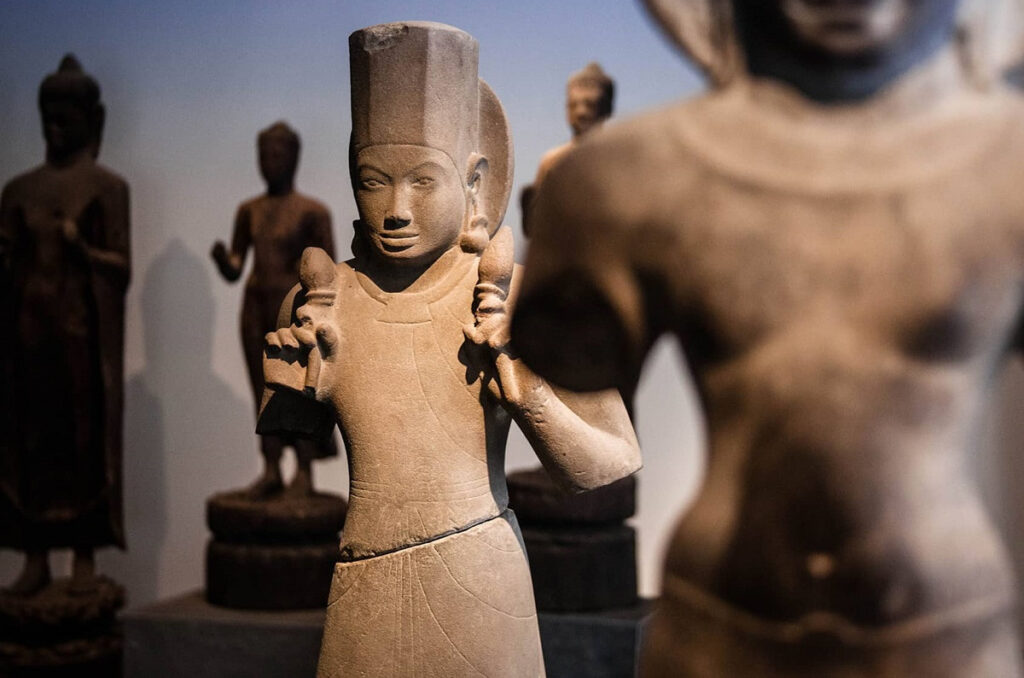
Opening Hours and Entrance Fee of Museum of Cham Sculpture
News: According to the latest decision from the city’s people committee, visitors don’t have to pay for entrance fees in the Cham Museum, in this year 2022. Fine Arts museum, the Da Nang museum and the Marble Mountains also open without an admission.
Cham Sculpture Museum in Da Nang opens from 7:30 to 11 a.m and 1 to 5 p.m daily and on public holidays. Its entrance fee is 60,000 VND for adults and teenagers above 16 years old. For smaller ages, it’s free. Need to reserve the ticket in advance? Our thought is “not necessary” because in fact, there is no limit of tickets sold in the day, even in high seasons. Just come to the official counters in 2 thang 9 St and buy.
Note: From 1st July 2022, the opening hours are from 7:30 to 11 am, and from 1 to 5 pm from Tuesday to Sunday. The museum closes on Monday.

Exhibitions in Da Nang Museum of Cham Sculpture
Map and Visit Route
Museum of Cham Sculpture now owns 10 permanent exhibitions and several themed ones. Each major exhibition showcases different works of art but all discovered in the same place or features the same art style. From the counters, visitors are recommended to walk from the “welcome room” where a big map hung up. The nexts are Tra Kieu, a themed gallery and then, return to Tra Kieu to see My Son and Dong Duong. In the back hall, should walk upstairs first. Gallery for Cham culture today and potteries their ancestors made. In the lower floor, sculptures from different parts of the former Champa kingdom are politely placed. The exit is next to the gallery for inscriptions.
Gallery of Tra Kieu
The first gallery is for Tra Kieu, the capital of the entire Champa kingdom from its formation in 2nd to early 14th century. It’s called by Cham people as Simhapura or “City of lion”. Today, remains of its walls and central temples are found 50 km south of Da Nang. The majority of what visitors see are dated back from 10th to 11st century, from excavations of French archaeologists from 1927 and 1928. Besides the largest, most important Tra Kieu Pedestal, Nandin holy cow, Vishnu god sculpture, “Tra Kieu fairy dancers” and the Linga-Yoni.
Gallery of My Son Sanctuary
30 km west of Tra Kieu citadel, My Son is Hindu sanctuary of Champa kingdom from 4th to 13th centuries. It’s a complex of over 70 towers but because of time, abandonment, wars and climate, only 20 of which are still standing. In 1999, this Cham ruins was recognized by Unesco as a world heritage site. After being rediscovered by the French, their first excavations were in 1903 and 1904. In the gallery, the Pedestal in My Son E1 temple is the star (see details in below section for national treasures). To its left, the story of Brahma god given birth from Vishnu’s navel is depicted. Nearby, a statue of Shiva god with characteristics of the king expresses how unique the sanctuary unique. Nowhere else, the god statue and his symbol object were worshipped in the same place. To know more about My Son sanctuary, read our article via centralvietnamguide.com/my-son-holy-land.
Gallery of Dong Duong
Dong Duong is a Buddhist sanctuary built in 9th century and during its lifetime, boasts of the grandest architecture in whole South-east Asia. Conflicts between Viet and Cham kingdoms cause its destruction, and now only a tower is standing. In Autumn 1902, two leading French archaeologists and workers excavated this important complex, and plenty of artifacts unearthed. The highlights are still the central pedestal where a large Buddha sits atop and the Tara goddess statue (see details in below section for national treasure). Sculptures of temple guardians (sitting on the cow) are among the biggest of the kind ever known.
Gallery of Thap Mam
Thap Mam is a runied temple excavated by French in 1934 and its age is about between 12nd and 13rd centuries. Many buildings and walls were seen, and the weight of sculptures found was up to 58 tonnes. Thanks to being unique and outstanding, an own style in Cham art was named the same to it, Thap Mam style. National treasure “Gajasimha” stands here (see more details in next section). This site is located within Vijaya citadel where Champa emperors placed their seat of power after 14th century.
Gallery of Quang Tri, Quang Binh and Hue
These localities are northernmost of Champa kingdom formerly, near borders with Viet people-led kingdom. Many vestiges of fortress, trading port, temple, walls and especially some standing towers are seen all over. What visitors see is dated back from 9th and 10th centuries, including a statue of half-naked Bodhisattva holding two penises on her hands (representing the growth).
Gallery of Da Nang
This gallery has a focus on sculptures found before and after 1975 when the Vietnam war ended, collected from different parts of the city. The ones were unearthed from two Hindu temples from 2012 to 2014, bearing witness to the long history of Da Nang.
Gallery of Quang Nam
Quang Nam (province) is home of many important Champa remains, from My Son sanctuary, Tra Kieu capital to Dong Duong Buddhist monastery. All have their own galleries to showcase, and this space aims to introduce sculptures from less famous sites. Tower of Chien Dan, Khuong My or Bang An for example. Read our guide to Hoi An Cham Temples to know further details about them.
Quang Ngai
Quang Ngai (province) is between two concentrations of Cham remains, Quang Nam and Binh Dinh. Many artifacts and sculptures were found around it, but still can’t see any temples. In 1904, a 11th-century temple was discovered by the French. In a nearby area (Thien But mount), Vietnamese archaeologists recently unearth the largest Linga-Yoni ever existed in the country.
Binh Dinh and Kon Tum
Other nice sculptures found in Thap Mam site or of the same style are exhibited here, in Binh Dinh gallery. It’s the capital of the Champa kingdom from 11st to 15th century. They date back from 12th century onwards. In the same space, Kon Tum’s collection was crafted later, between 14th and 15th centuries.
The Inscriptions
Cham people used Sanskrit inscriptions to write and carve on rocks or steles in the temples, for memorial. From 10th century onwards, they changed to use the ancient Cham inscription. Because of wars, too many books and other documents on paper were burned or lost, so the carved words became priceless sources of information. Some steles in this room were brought from the holy My Son sanctuary.
Sa Huynh and Champa Potteries
Here, visitors can have a look at pottery made by Sa Huynh inhabitants before 2nd century and their successor Cham people. The most special artifacts are burial jars where early people kept the ashes of their family members, typical to Sa Huynh culture.
Cham Culture in Ninh Thuan
12% of Ninh Thuan province’s population is Cham people and it’s 40% for the entire Vietnam. As rich as their ancestors Champa kingdom, current Cham culture now is featured, both tangible and intangible. Their traditional costumes, houses, crafts, festivals, music instruments and more are on display in this gallery.
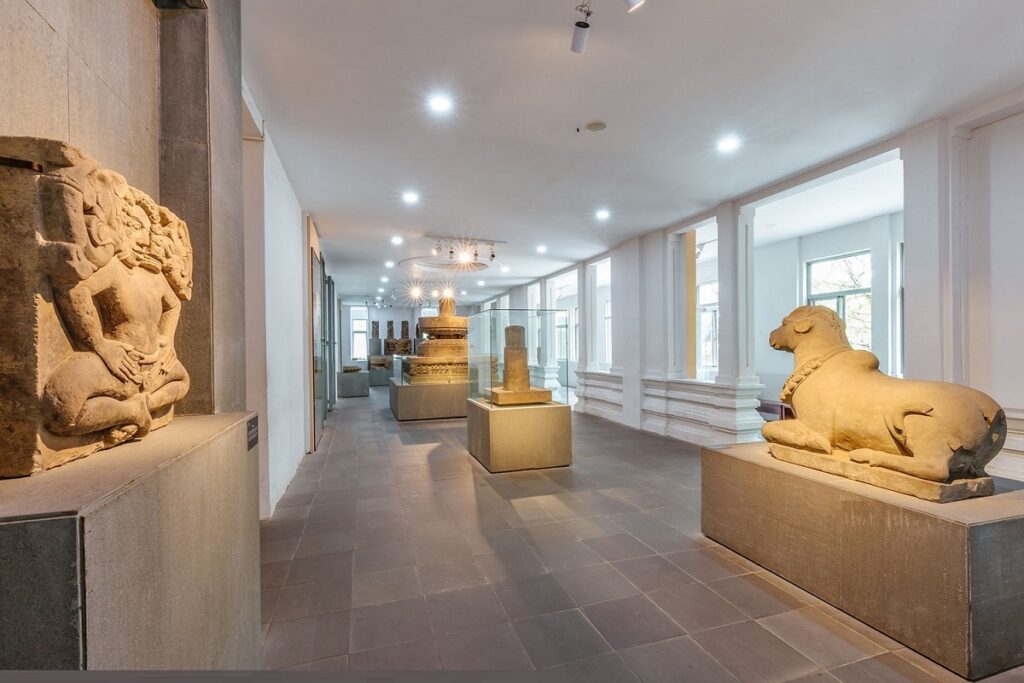

National Treasures – The Best in Museum of Cham Sculpture
Tra Kieu Pedestal
Heart of Tra Kieu gallery is “Tra Kieu Pedestal”, sculpted between the 12nd and 13rd centuries. Moved to the museum in 1981, this sandstone work was registered as a Vietnamese national treasure in 2012. It consists of one squared base with intricate carvings on each side and sacred Linga-Yoni above. Meaning of the carvings dare historians for decades and now a part of it may be unlocked. According to their thought, that is the marriage of Sita and Rama in the Indian Ramayana epic. On the side looking outside the yard, Apsara dancers are performing to congratulate. To the left, Rama breaks the bow which was never broken by any men previously, to have an opportunity to get married with Shita and the next (closewise), he gives his wedding presents to the father of the girl. The last scene depicts an exciting wedding procession.
My Son E1 Pedestal
Dating from 7th to 8th centuries, “My Son E1 Pedestal” stands in the centre of the My Son gallery. It originally included 16 sandstone blocks but now only 14 remains. According to historians, this national treasure is only of its kind featuring decorations with patterns and motifs exclusive to a temple. On its squared base, visitors can see Hidu monks in the forest, besides animals, lotus and fern leaf. In the front side, 6 female dancers perform and give a strip of silk to the god. Placed above, there are two Ganesha elephant-headed gods and one Skanda “the god of war”. The first ones represent wisdom and prosperity, and expressed in both standing and sitting styles. The larger one was founded in 1903 in E5 Temple of My Son sanctuary and borrowed to exhibit in France’s Guimet museum and USA’s Metropolitan museum.
Dong Duong Pedestal
In the left corner of Dong Duong gallery, “Dong Duong Pedestal” was made sometime between 9th and 10th centuries. In 2018, proudly it’s praised to be a national treasure by the Vietnamese government. Compounded by 24 sandstone blocks, there are about 30 carvings varying in content in its base. The scene of Maya queen (Buddha’s mother) in Lumbini garden, Buddha shaving his hair and changing clothes with a hunter, Buddha’s henchman and horse going back home after practicing his religion in the forest are depicted, for example.
The largest Buddha in Champa’s history ever was placed on the highest location (because Dong Duong was a Buddhist monastery). It was discovered in 1902 in the innermost enclosure where the Central temple standed, but in different pieces. Meanwhile, archaeologists found two heads, and it seems that both were not really a part of the statue formerly. The head picked was just the better one. Some historians say this Buddha was brought from another country to Champa because of its “strange” style.
Statue of Bodhisattva Laskminda-Lokeshvara (shortly Tara Statue)
Crafted in 9th century, this 130-centimet bronze goddess statue stands in Dong Duong gallery. It is a half-naked Bodhisattva who wears a long sarong, holds the lotus by right hand and the conch by left hand. For historians, the bronze statue is rarely made throughout the history of Champa kingdom and it may be the best. For that reason, the Prime minister recognised it as a national treasure in 2012. What the visitors see today is a copy, not original.
The story behind the Tara statue is interesting. In 1978, it was discovered by accident in Dong Duong monastery. Then, locals kept it very carefully and saw it as a village’s treasure. Leader of the village was responsible to preserve and protect it from hands from anybody on the outside. Many collectors came and asked to buy this unique bronze work, but all failed. Because of that, the government knew of its presence and quickly after requested to place it in the Cham museum. Villagers disagreed for some decades, and one day, they changed their mind and gave it to Da Nang police. However, the lotus on the right hand was broken previously. Recently, luckily it was returned to the statue.
The Gajasimha
Gajasimha is the highlight of Thap Mam gallery. Carved in 12nd century, this 2,5-meters-tall sculpture is an intricate half-elephant-half-lion shape. After being unearthed by archaeologists from the French school of the Far East, it arrived at the museum in 1935. In Hindu thoughts, its head (of the elephant) symbolizes power of the gods and its body (of the lion) is for the victory of emperors. In Cham temples, this statue often stands in the main entrance, to express solemnity and importance of the building. In 2020, Vietnam’s Prime minister added “Gajasimha” in the national treasure list, thanks to its most intactness and largest among all sculptures found in Thap Mam.


How to Get to Da Nang Museum of Cham Sculpture
Location of Da Nang Museum of Cham Sculpture
Da Nang Museum of Cham Sculpture is near the intersection of 5 roads and close to Dragon Bridge spanning the river. Therefore, travelers have no difficulty in finding a ride to get to it, from wherever in the city. Although standing next to the riverside, usually people don’t reach this featured attraction by water. Distance from the airport is also quite short, only 2,5 kilometers (10 mins by taxi). So, the museum luckily becomes the first place to sightsee for travelers by air. During the transit, a visit is feasible.
In Da Nang
The museum is in the heart of the city and by major roads. So, any road vehicles are convenient to get to and get from any areas in the city. Guests of riverfront hotels nearby can take a short walk to this attraction. If staying over in further places, like My Khe beach hotels, An Thuong “western quarter” or somewhere else around the downtown, a taxi ride is popularly selected. Convenience and moderate price are advantages. For visitors who plan a half-day or full-day experience, private car and motorbike rentals are their choice, due to lower cost. If expecting an itinerary with a knowledgeable guide and things only known by locals, an organized tour becomes most suitable. Buses are feasible, including public bus and hop-on hop-off bus.
Da Nang Hop On Hop Off Bus
Touring the city and hop on or hop off famous tourist attractions with Da Nang hop on hop off bus, absolutely is one of the nicest options. It departs from the airport from 7 to 8 a.m and then runs until 10 p.m. There are two routes available now: “Da Nang city tour” and “Cocobay beach tour” and both provide a stop at Cham museum. Price of a seat is 250,000 VND for adults and valid for 24hours from when visitors get on the buses. Besides air-conditioned seating, it’s possible to grab open-air ones on the upper floor to feel the cool breeze and view the city’s life better.
Get to Cham Museum from Hoi An
Da Nang Museum of Cham Sculpture is just 30km northwest of lovely Hoi An. Personal and private vehicles are the best to get to each other. For a half-day or full-day experience around Da Nang city, travelers often book a car rental or ride a motorcycle by themselves. The better one depends on your budget, travel plan and style. Thanks to being on the way to Da Nang airport, lots of people make full use of the transfer to stop and see before check in time. It’s smart, money-saving and convenient.
Public Hoi An Da Nang bus (No 1 bus) provides the ride from Hoi An bus station, from 5:30 a.m. It takes around 45 minutes to arrive at “Cham museum station” and on the way, visitors can leave the bus to sightsee the Marble mountains. The museum closes at 5 p.m, so should get earlier than 3 to feel relaxed to get to and visit. Ticket price is 20,000 VND. This bus also is helpful to get from Da Nang central bus station to the museum, after 40 minutes.
Parking Lots and Fee
Parking lots are many to leave bikes near the counters (2 Thang 9 St), with a price of 5,000 VND. If planning to see Dragon Bridge or go somewhere else for refreshment or eating, just return to the museum before it closes.
Get to Cham Museum from Hue
The most convenient way to get directly the Museum of Cham Sculpture from Hue, is by motorcycle. Travelers can choose to ride by themselves with or without a tour guide and get a pillion ride behind an experienced driver. Tour itinerary often departs in the morning and stops at Hai Van Pass before arriving at Da Nang. If the final stop is in Hoi An, the striking Marble Mountains may be included. For other attractions (like the museum), needing to deal with the operator in advance. It takes around 3 hours to get to and if skipping the mountain pass and picking the tunnel, it’s shorter around 40 mins. A jeep ride is available to book too. Read our articles for How to Get to Da Nang and to Hoi An from Hue, for further details.

Things to See and Do near Da Nang Museum of Cham Sculpture
Dragon Bridge
This most unique bridge crossing over Han river, is just next to the Museum of Cham Sculpture. Walk across the wide boulevard and you will see it immediately. The head of the dragon is on the opposite bank and while reaching there, the view over other bridges and waterfronts are really pretty. During the sunset, it’s more stunning. See everything about Dragon bridge in our article centralvietnamguide.com/dragon-bridge-danang.
Da Nang Night Market aka Son Tra Night Market
After the visit to the Cham museum is completed, visitors can stroll on the Dragon bridge to come to the Night market, on the opposite bank. Amongst 150 stalls, local foods, barbecues, seafoods, souvenirs, clothes and more can be seen. See details in centralvietnamguide.com/da-nang-market.
An Long Pagoda
Next to the Museum of Cham sculpture, this small pagoda was formerly called An Thu temple. The most precious thing it has kept is a stone stele carved in 1658. Its content includes names of donors (to build the pagoda), reasons to build and explanation of the name. Historians say it’s the oldest stele known all over the city, and for that reason, has been submitted to be a national treasure.
Da Nang Fresco Village
A few walks from the museum, visitors will see many mural paintings in this free attraction, in the alley of 75 Nguyen Van Linh St. The creative works depict life of citizens and famous places.
Bach Dang Riverfront
Bach Dang waterfront is prettier than any stretches of Han river banks. Between two famous bridges, the Dragon and the Han River, this promenade features spacious paved walkways, lots of trees and flowers. Both day and night, pedestrians enjoy cool breeze, scenic views over the waters and top of Son Tra mountain. At night, there are some top bars, pubs and rooftop bars opening to the left of it.

Where to Eat near Museum of Cham Sculpture?
Banh Mi Ba Lan
A short walk from Museum of Cham sculpture, this locally-run eatery serves the best banh mi in the city. Its signature sandwich is banh mi que, the stick bread stuffed with meats, pate, sauce and veggies. Options are limited, with a price ranging from 10,000 to 25,000 VND. Everyday, it opens from 3:30 p.m until everything is sold out.
Huynh Thuc Khang Street
This street is home of many local food restaurants, standing next to each other. Visitors can expect delicious noodle dishes, rice cakes, Da Nang signature pork rolls with anchovy sauce or the specialty Nam O fish salad. Serving mainly for locals, so the price here is moderate.
Son Tra Night Market
This night market is among the nicest choices to taste local street foods after it’s dark. Fresh seafood cooked on open-air barbecues and Da Nang’s local foods are highlights, sold at a not expensive price. Visitors can choose to enjoy the shimmering Han riverfront with cool breezes.
Fatfish Restaurant & Lounge Bar
At 439 Tran Hung Dao St, this river-facing venue opens from 10 a.m to 10 p.m daily. Its menu provides yummy fusion dishes from Mediterranean and Asian cuisines, outstanding craft beers, chilly cocktails, carefully-selected wines and house bakery. Price of the mains ranges from 100,000 to 550,000 VND, and for drinks, it’s from 30,000 to 350,000 VND.
Olivia’s Prime Steakhouse
At 505 Tran Hung Dao St, this fully air-conditioned restaurant opens its doors from 4 p.m to midnight. It caters tasty meat plates cooked from high-quality ingredients, over wood-fired grills and in American vibes. Beside that, pastas, foie gras, salads, carpaccio and some homemade dishes, also available to dine out.
Red Sky Bar & Restaurant
A short walk from Museum of Cham Sculpture, this western-styled restaurant is known for valued steaks. Each plate is made from imported meats and prepared by the chef who has experience over 20 years in luxury venues. Beverage choice is some dozens, to select for enhancing the taste and includes 30 types of wine produced in different countries.
Pizza 4P’s Hoang Van Thu
At 8 Hoang Van Thu St, it takes a few minutes to walk in this Italian Japanese restaurant. Established in 2011, Pizza 4P’s serves pizzas cooked in a fire-wood oven, with homemade cheese freshly produced in Da Lat and carefully-picked ingredients. It’s featured in many TV shows, social media and several magazines. Seatings are available for solo travelers, couples or groups of friends, in an air-conditioned and cozy atmosphere.
Da Nang Museum of Cham Sculpture Tour
Half-day Tour
A half day tour to the Museum of Cham sculpture also includes another attraction in Da Nang, such as the Marble Mountains, Lady Buddha, bridges or beaches. If would like to have a focus on the historic center of the city only, a walking tour is recommended. In the afternoon, visitors also have a chance to taste different local dishes and later the Dragon Bridge fire show (on the weekend). To design your half-day experience easier with our advice and recommendations, contact us via whatsapp number (+84) 968009827 or email centralvietnamguide@gmail.com.
Full-day Tour
One day itinerary can introduce the visitor to all highlights around Da Nang, including stunning attractions, history and culture. The most popular transportation is by car and lunch is included or optional, up to personal requirement. There are some recommendations you may be interested in:
Itinerary 1: West experience (Ba Na Hills, Golden bridge, Cham museum and Dragon bridge).
Itinerary 2: Da Nang city tour (Cham museum, the Marble Mountains, My Khe beach, Dragon bridge, Lady Buddha, Pink church, Han market).
Itinerary 3: Northwest experience (Hai Van pass and ancient gates, Lap An lagoon, oyster village, Lang Co fishing village, Cham museum, Dragon bridge, Pink church, Han market).
To know details or customize your day experience, contact us via whatsapp number (+84) 968009827 or email (centralvietnamguide@gmail.com).
My Son Sanctuary and Cham Museum Tour
This tour specializes in Cham culture and Champa kingdom ruled the land from 2nd to 14th centuries. The focuses are indoor Museum of Cham sculpture and outdoor My Son sanctuary, a Unesco world heritage site. In the holy land, visitors can expect a complex of majestic Hindu temples and ruins located in an unspoiled environment. The knowledgeable guide will share all secrets behind towers, objects, gods, and more. The best time to visit is in the morning. His sharings continue in the museum where some of the most unique Cham sculptures have been preserved. If looking for a suitable itinerary with these places (as inclusions), contact us to know recommendations. Our whatsapp number is (+84) 968009827 and email is centralvietnamguide@gmail.com.
If looking for a local guide who is fluently in English, friendly and knowledgeable, text us in whatsapp number +84968009827.
See also: My Son Sanctuary Tour
Related Posts
Non Nuoc Beach: The Famous Beach of Da Nang
Besides the Golden hands bridge – a global hit, Da Nang city also has beautiful beaches. If looking for somewhere great to stay and have a slow holiday, Non Nuoc beach should be one of top choices. It’s lengthy, peaceful,
How to Get from Da Nang to My Son Sanctuary
Known as ‘the Angkor Wat of Vietnam’, My Son sanctuary boasts of its sophisticated temples dating back from 4th century. Sadly, in 14th century, it’s abandoned in the forests. Today, this is one of the most important archaeological sites in
Bach Ma National Park: Hiking, Trekking in Da Nang and Hoi An
Two best places for trekking and hiking in and near Da Nang are Son Tra mountain (peninsula) and Bach Ma national park. Which one is better is actually personal because these hot spots have similarities and differences. The same things they
Am Phu Cave (Hell Cave) – Things to Do in Da Nang
Although in the Marble mountains – the most visited attraction in Da Nang, travelers often miss Am Phu cave. One of reasons is that it’s mentioned much online and not recommended by travel companies (time for the mountain itself is
Asia Park and Sun Wheel in Da Nang (Sun World Da Nang Wonders)
Have you ever seen the wheel of Da Nang? That is the Sun Wheel. It’s a part of greater Asia Park – an amusement park with a heap of fun games and kool rides.Travelers often visit Ba Na Hills when
How to Get to Golden Bridge from Da Nang
The Golden Bridge (aka the Golden Hands Bridge) in Da Nang is a must visit attraction in Vietnam today. Many foreign travelers come to the city, just because they love seeing it and taking some good pictures. Placed in the
Da Nang Food Specialties: What to Eat in Da Nang
Da Nang is known as a food capital of central Vietnam. This city boasts many yummy dishes, prepared by distinctive recipes and some of them are famous all over the country. Someone says that its culinary culture is influenced by
How to Visit Golden Bridge Vietnam
The Golden Hand Bridge of Ba Na hills today is a dream place to visit for many travelers. Since it opened in June 2018, millions of people have set their foot on this amazing bridge. Of course, an uncountable number
Da Nang Shore Excursions: Guided Tours From Tien Sa Port
Da Nang Vietnam today is one of stopovers for many cruises that travel from continent to continent, from country to country. It owns an ideal seaport to moor and it provides travelers awesome spots to visit and activities. The distance
Han Market (Cho Han): Where to Shop in Da Nang?
In the heart of Da Nang, the Han market is a popular place for visitors to buy something to bring home due to the diversity of merchandise. Back to history, it was built by French people as a part of
Da Nang Cathedral (Da Nang Pink Church)
Da Nang became a French protectorate on 3rd October 1888, under the name “Tourane”. By the Han river, the colonists designed a grid of streets with public buildings, a city hall, a market, train, and a church. Over time, these planned
Things to Do in Ba Na Hills Besides Golden Bridge
According to local authorities, 50% of visitors coming to Da Nang and Hoi An visit the Ba Na hills. In other words, that is nearly 10 millions of people. This statistic indicates that the hill station is one of the
Da Nang Half Day Tours
In addition to day trips, travelers have many options of half-day tours in Da Nang to choose from. Not to spend a full day at different places, maybe far from the hotel, it’s more relaxing with one or two attractions
Da Nang Private Car and Driver
Your next holiday destination is Da Nang? You prefer to travel by yourself? Hiring a private car is one of the best options for you to explore with freedom, flexibility and enjoy a personalized itinerary. Somehow, you can save money
Da Nang and Hoi An Itinerary for Visitors Staying Overnight in Hoi An
Da Nang and Hoi An are twin cities in the heart of Central Vietnam. Both are popular tourist destinations for either domestic or international visitors, and share many similarities. Due to smaller, quieter and “three stunners ” – Old town,
Da Nang Things to Do: Guide to What to Do in Da Nang Vietnam
Unquestionably, Da Nang deserves a holiday trip from all types of traveller. Firstly, due to the weather. It has a longer sunny time than the north but less hot than the south. During the wet season, it’s least affected by
Da Nang Best Things to Do and Reasons
Da Nang is the largest tourist center in Central Vietnam. It owns fascinating natural and cultural places that attract both Vietnamese and foreigners. In the busiest year, this city of bridges draws 8,6 millions of visitors. Therefore, it is not
How to Get From Hoi An to Da Nang
Da Nang is the neighbouring city of Hoi An. It's the capital of Central Vietnam and has the most important (busiest) transport hubs of the region, such as airport, train station, bus station, cruise port. No doubt, it’s the gateway
Hoi An or Da Nang: Which is Better for First Time Visitor?
Da Nang and Hoi An are located in Central Vietnam, with a distance of roughly 30 km. To the north, Da Nang is the capital city of the region, with a contemporary appearance and down south, Hoi An is a
My Son Sanctuary Tour
My Son Sanctuary is a Unesco world heritage site, attracting 450,000 visitors in recent years. It’s the best remains left by the fallen Champa Kingdom which ruled a part of Vietnam from 2nd to 19th centuries. Forgotten by people in nearly a
Da Nang Best Area to Stay: Guide to Where to Stay in Da Nang
In the Central coast, Da Nang has an area of 1,285 km2 and population of 1,134 people, making it become Vietnam’s 4th largest city. It plays an important role in the economy, finance, commerce, transportation, and of course, tourism of the
Da Nang Cave Tour: Best Underground Activities in Da Nang
Different from Hue and Hoi An, Da Nang has limestone caves and grottoes. All of them are within the Marble Mountains (Ngu Hanh Son), a complex of 5 amazing hills formed by a broken dragon egg in the legend. It’s
Da Nang Best Time to Visit: Guide to Best Weather in Da Nang
Da Nang is titled “Asia’s leading festival and event destination” by the World Travel Awards or Vietnam’s greenest city by the WWF. Its reputation comes from amazing natural mountain-to-sea sceneries, richness of local culture and magic transformations in recent decades.
Da Nang Weather by Month: Guide to Monthly Weather in Da Nang
In Central Vietnam, Da Nang has a tropical monsoon climate with two distinct seasons that each starts later than the North 2 months. Because of being shielded by the spectacular Hai Van Pass Range, it’s not much affected by the
What to Do in Da Nang At Night
Between the sunset and midnight, there are many things to do in Da Nang that travelers should know before getting to bed. Thankfully, different styles of traveling, budget or ages can find their own fitted one(s) to get entertained. The
Lang Co Vietnam Travel Guide
Lang Co was a lovely backwater town nestled at the foot of spectacular Hai Van Pass for some decades. Not yet widely known because of the popularity of beaches in Da Nang and Hoi An, it’s a real hidden gem.
What to Do in Da Nang for 3 Days
Da Nang is a lovely coastal city in the middle of 3 Unesco world heritages Hue, Hoi An and My Son Sanctuary. This most worth-living municipality owns a poetic river running through its heart, uniquely-designed bridges, white sandy beaches and
My Khe Beach: A Complete Guide to Da Nang’s Best Beach
Da Nang is a lovely seaside city with many beaches, and the best is My Khe. Located on the eastern coastline, it’s between little-known beaches near the foot of Son Tra Mountain and well-known Non Nuoc Beach lined with luxury
Da Nang Day Trips: Guide to Best Day Tours From Da Nang
Centre and outskirts of Da Nang have incredible attractions where travellers need to spend many hours to get to and fully explore. There are the Ba Na Hills and Golden Bridge on its slope, Hoi An Old Town and its
Museums in Da Nang
Da Nang has many museums where visitors can see and learn a lot. Generally, their exhibitions have different themes, varying in stages of the history, groups of people (communities) having lived in the city, art styles and more. Around the oldest
Linh Ung Pagoda: Trio of Da Nang’s Holiest Mountain Temples
Linh Ung means “wishes answered miraculously” in Sino-Vietnamese. And it’s first used in 1841 to name a pagoda in the Marble Mountains by Thanh Thai, the 10th king of the Nguyen Dynasty. Until the 21st century, that is still only
Da Nang Night Market: A Thing To Do in Da Nang at Night
Different from day markets in Da Nang, night markets are held open-air and on streets where traffic is active during sunny hours. A visit there provides the chance to understand better local products and culture, from food, drink, handcrafted objects
Guide to Son Tra Mountain (Monkey Mountain) in Da Nang, Vietnam
From My Khe Beach or Han River promenades, tourists can see a part of the Son Tra Mountain. Although being near the city center, natural forests on its slopes have been preserved well, and it's no surprise that it’s called
Ba Na Hills Tour
Ba Na Hills is one of the best attractions in Da Nang, and the country. Its full name is the Ba Na-Suoi Mo Tourist Area, made from “Ba Na hill station” and “Suoi Mo or the Dream stream”. It was
Da Nang Cable Car
No surprise that now, when travelers make the plan to tour around Vietnam, there are many cable car rides recommended. Some are top things to do in its cities. The aerial journey may be from the plain to top of
How to Get from Da Nang Airport to Hoi An
Located in the city of the same name, Da Nang airport is the nearest airport to Hoi An. So, if travelers want to see an extremely-colorful Lantern festival or try unique Cao lau noodle, a flight ticket to Da Nang
Da Nang to Hoi An: Best Da Nang Airport Transfer and More
If traveling to Hoi An by air, train and cruise ship, visitors will come to Da Nang first and then have a transfer. The largest city of Central Vietnam holds the busiest airport, train station, port and bus stations of
Hai Van Pass Da Nang: Map, Route, Weather, History, Tour
Truong Son or Annamite Range is the most dramatic mountain ridge in Vietnam. When it juts out into the sea, spectacular Hai Van Pass is formed. This amazing sculpture of nature is a high wall where two sides of it
Da Nang Attractions Guide: What to See in Da Nang Vietnam?
Da Nang is the capital city of the Central region, and one of the most attractive destinations to tourists in Vietnam. It’s established by French colonists and called by them as Tourane in 19th century. Now, this coastal municipality is home
Guide to Lady Buddha (Goddess of Mercy) in Monkey Mountain, Da Nang
From the East coast, visitors can see an enormous white statue with the mountain backdrop, that is the Lady Buddha Da Nang. Located in the ground of Linh Ung Pagoda, she was sculpted by artisans in Non Nuoc marble village.
My Son Sanctuary Travel Guide
My Son Sanctuary is a complex of Hindu temples and a Unesco world heritage site from 1999. It’s 40 km away from Hoi An and 70 km to the southwest of Da Nang. Thanks to being the religious centre of
Da Nang Museum of Cham Sculpture
Da Nang Museum of Cham Sculpture is a highlight of the Han river waterfront. It’s established by French archaeologists to preserve intricate works of art of Champa kingdom, which ruled the land from 2nd to 14th centuries. Now, it has
Dragon Bridge Da Nang: The Fire-Breathing Da Nang Bridge
Praised to be the world's 30 most unique bridges recently, Dragon Bridge became the new icon for a Han river bridge in Da Nang. Spanning from the 100-years-old Cham Museum, it provides the quickest passage from the airport to My
Ba Na Hills Travel Guide: A First Timer’s Complete Guide
50% of visitors to Da Nang plan to visit Ba Na Hills in their itinerary. It’s larger for first timers who may know about its inspirational Golden Bridge, world-record cable car, huge French Village or theme park. Due to usually
Golden Bridge Da Nang: A Guide to The Iconic Da Nang Bridge
Recently-built but at the present time, the Golden Bridge Da Nang is one of the awaited attractions in Vietnam. On a slope of high foggy mountain, this delicate bridge and its images have inspired countless travelers. In the peak year,
Da Nang Bridge: A Guide to Famous Bridges in Da Nang
Da Nang has many bridges, and some of them are famous nationally and internationally. Before the recently-built Golden Bridge which made a boom in social media, people only knew bridges spanning Han river. In the 1990s, there were no other
Ba Na Hills Cable Car: World Record, Cost, Reschedule, Map
Cable car is one of the first ideas travelers think about Ba Na Hills, a Da Nang’s top attraction. It helps to shorten the time to get to the hills from lower plains, improve visitor safety and reduce air pollution
Da Nang Mountain Temple: Marble Mountain’s Pagodas, More
Da Nang has many mountain temples where handmade architecture, natural sceneries and religious values are combined perfectly. So, travelers will see, enjoy and learn a lot about different things just within a visit, to any of them. Above all, the
Da Nang Caves: Underground World of the Marble Mountains
One of the priceless gifts Mother nature gives to Da Nang is an array of caves and caverns. Almost all are located in the Marble Mountains, a complex of five marble and limestone hills, 10-mins drive from the downtown.
The Marble Mountains: Guide to Da Nang’s Iconic Mountain
Had been an offshore group of islands, geological activities shifted the Marble Mountains to the land some thousands of years before. Today, its marble hills rise suddenly up to over 100 meters from the surrounding delta. All are impressive and how


